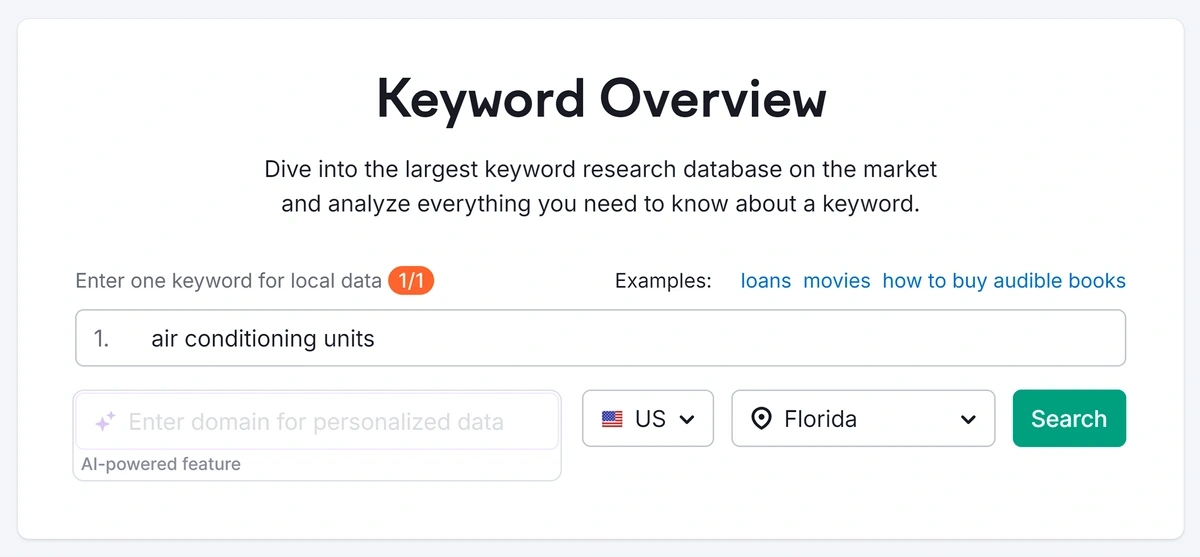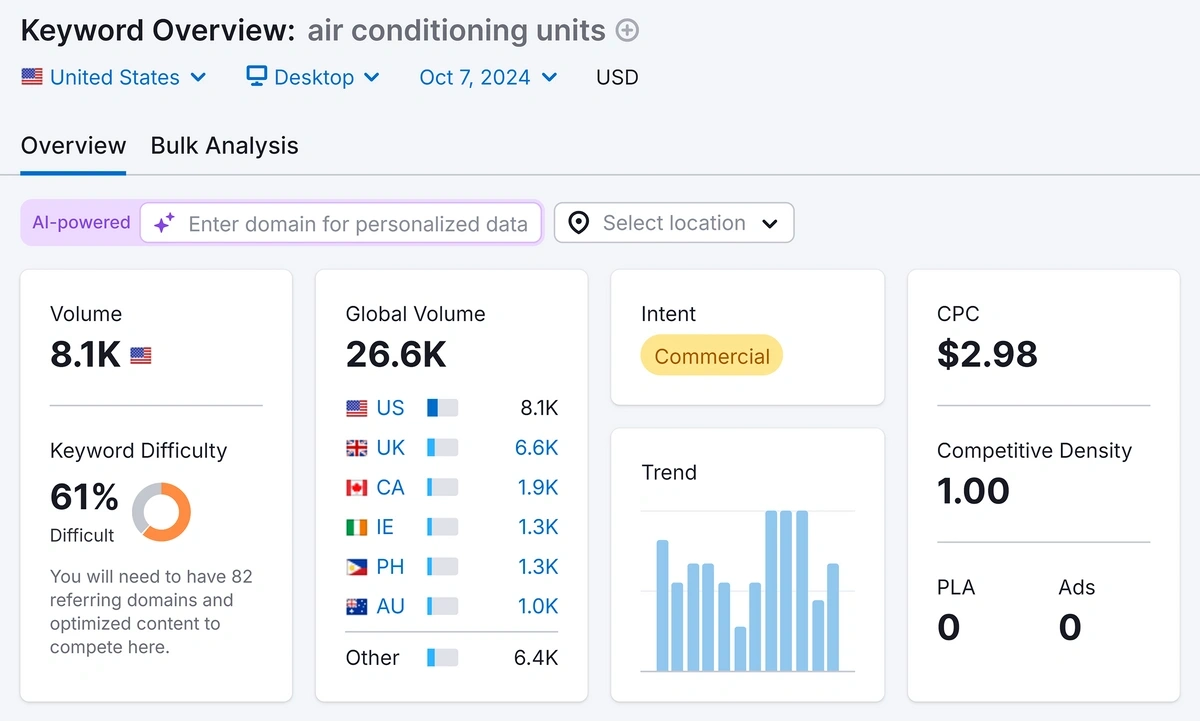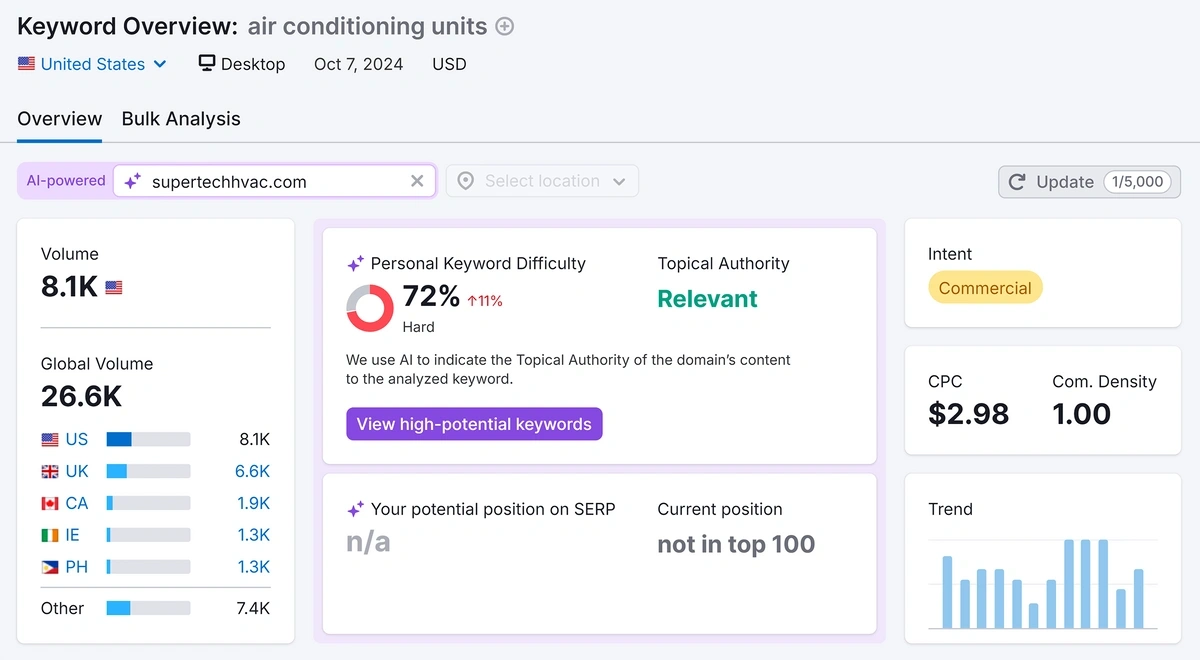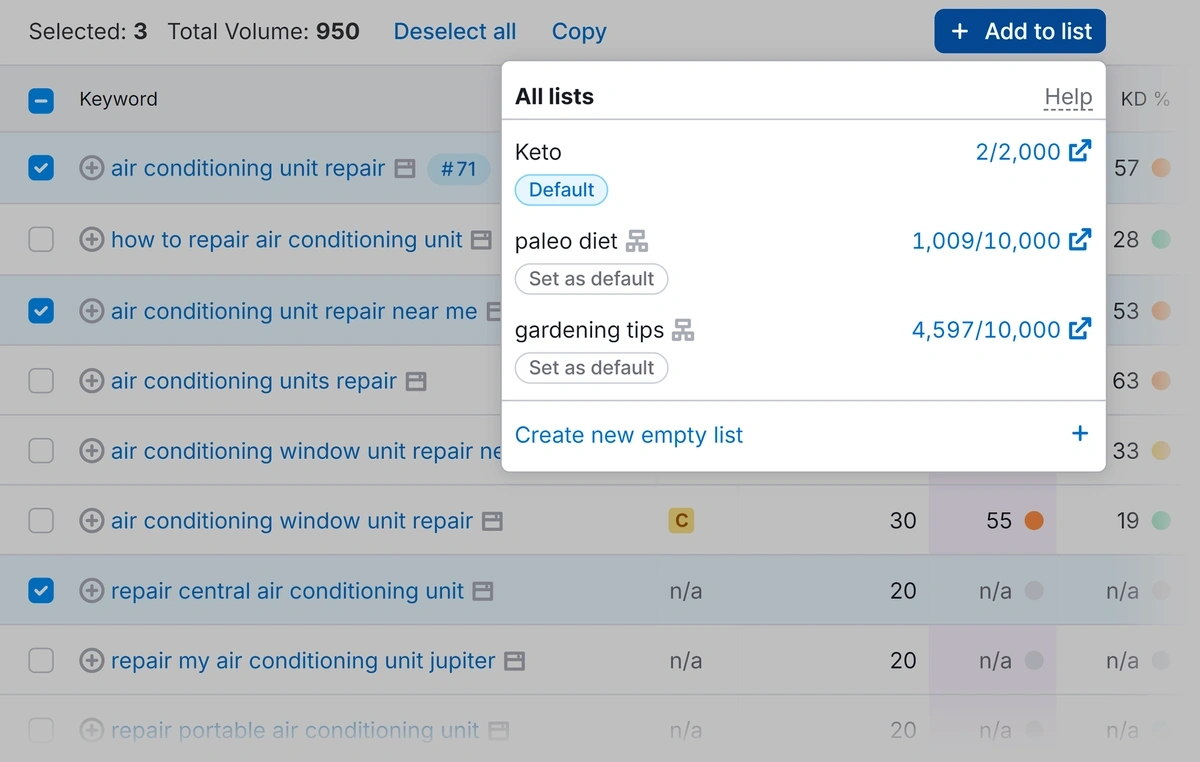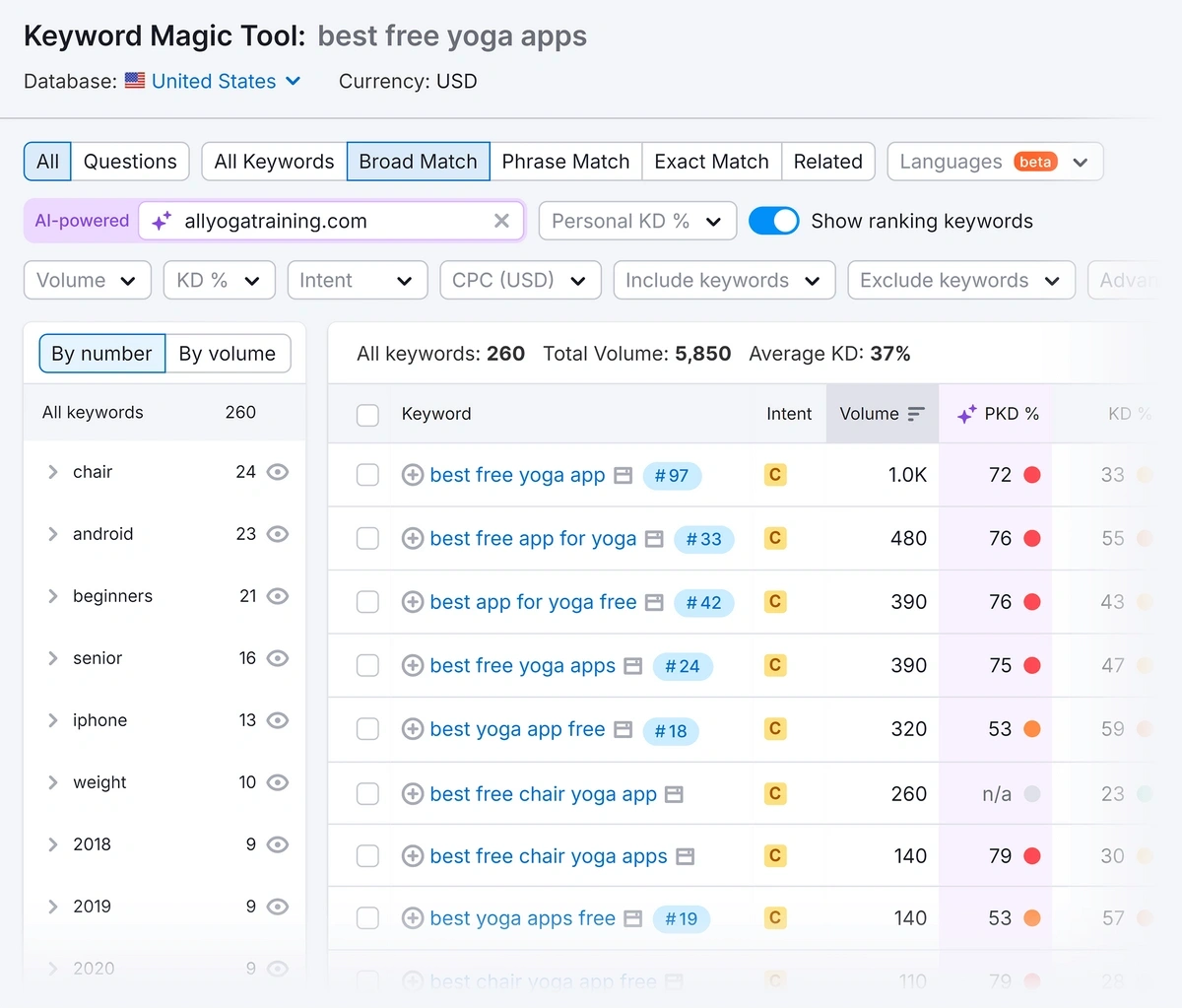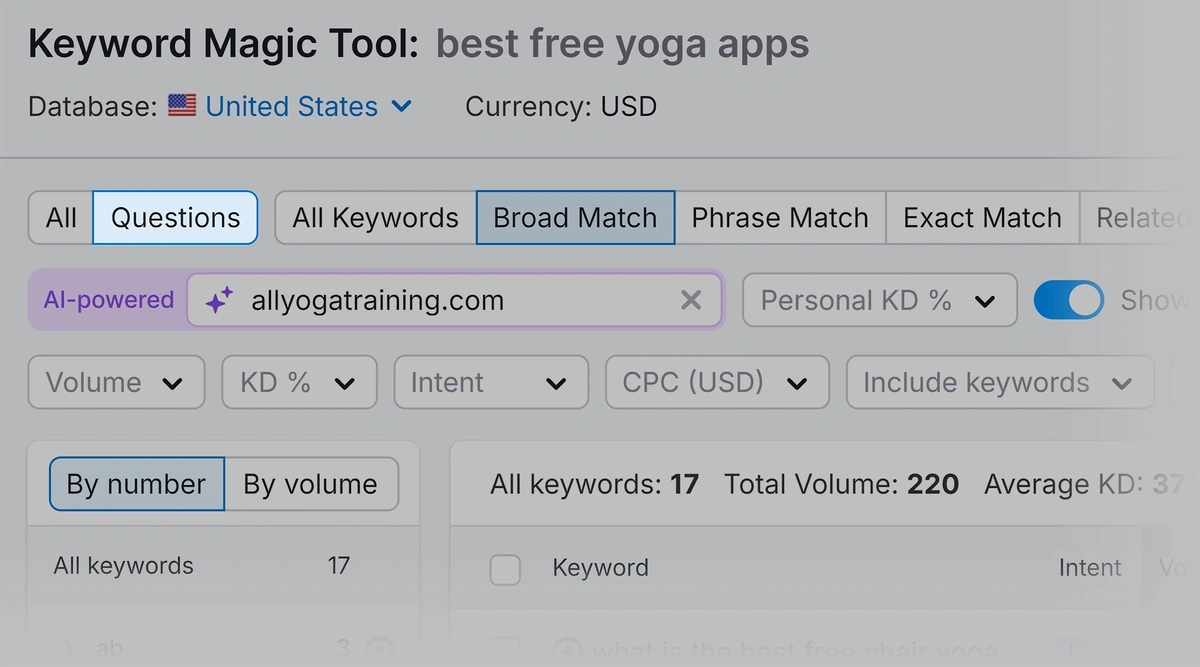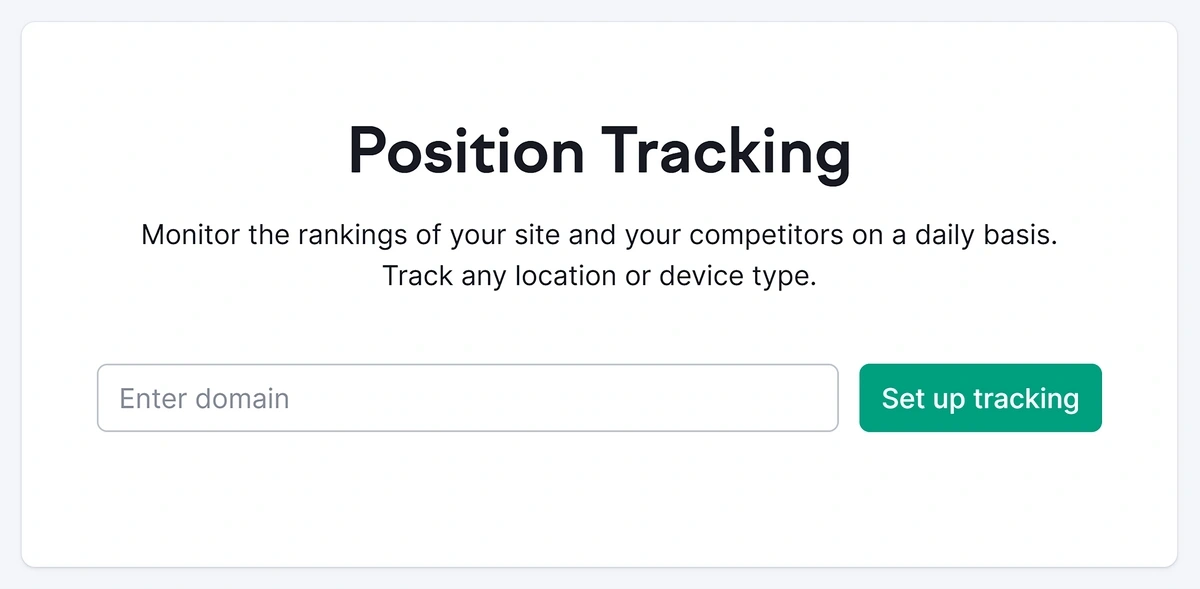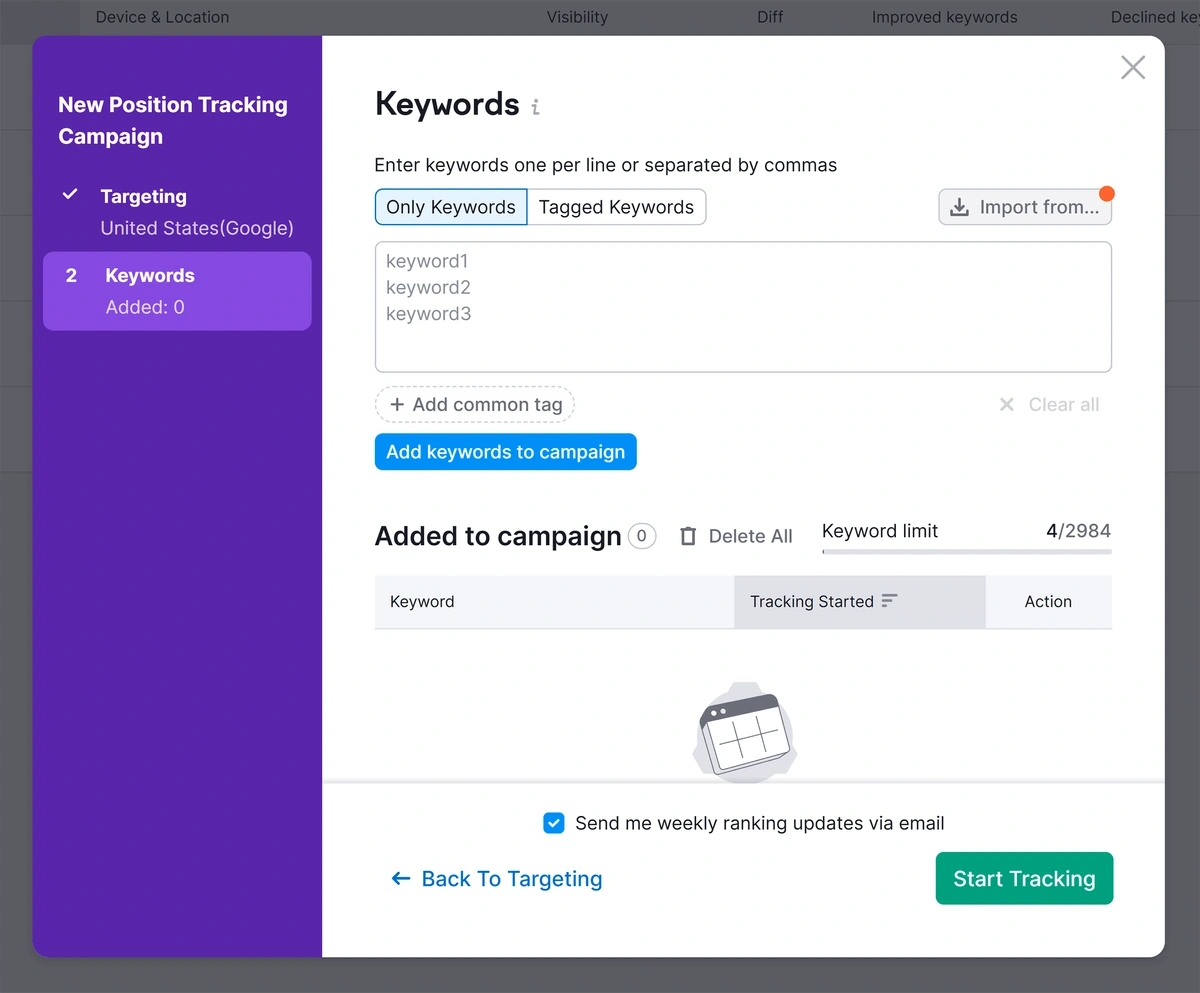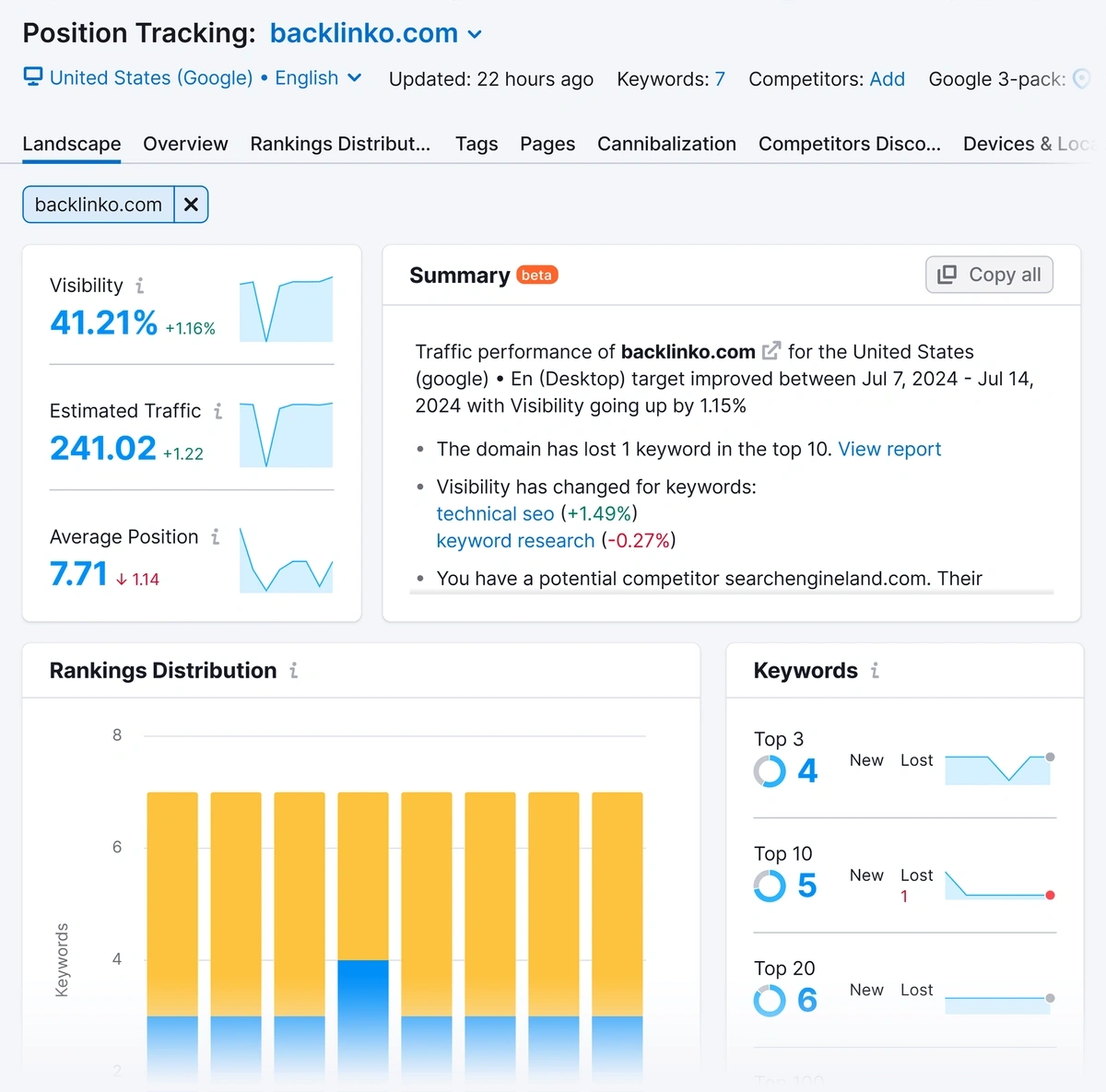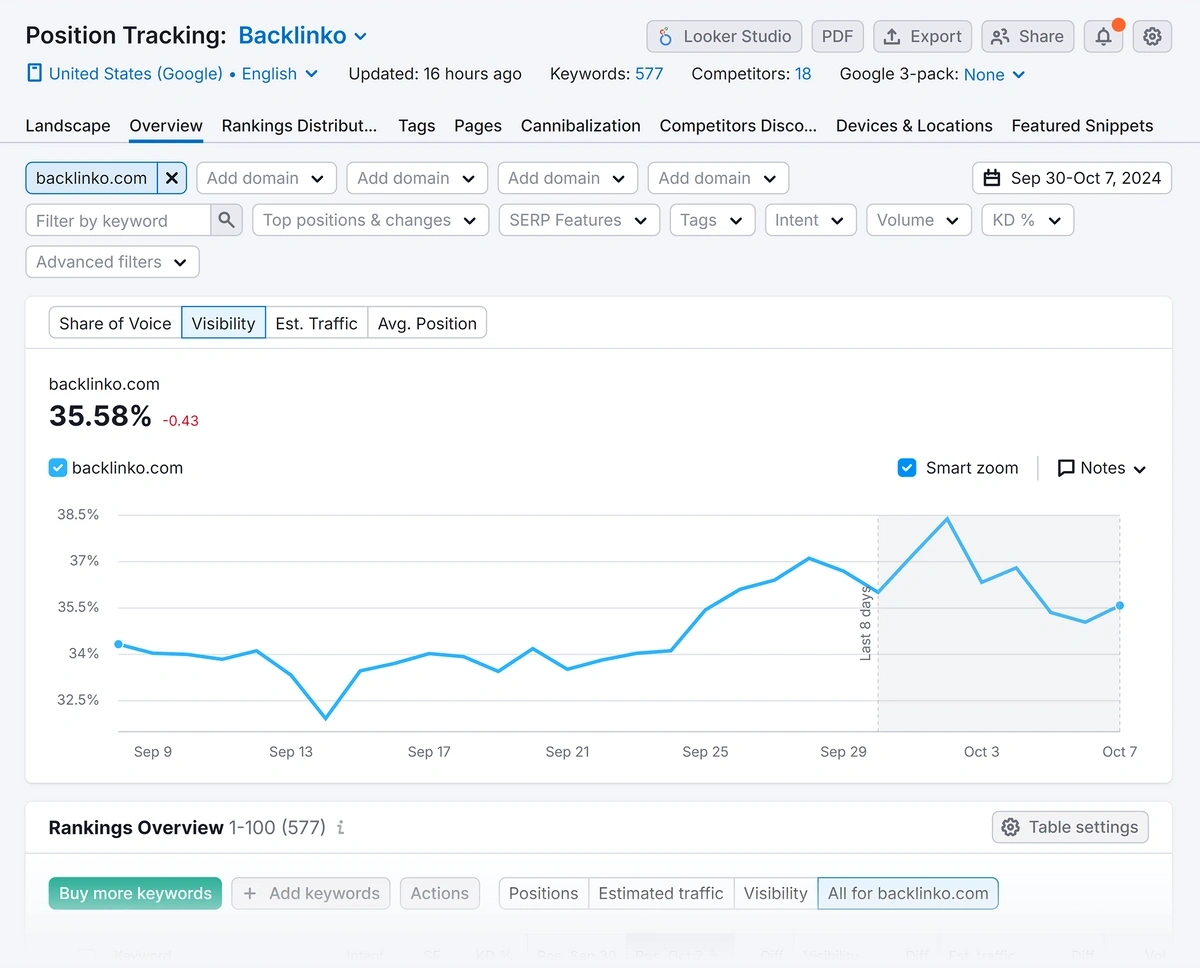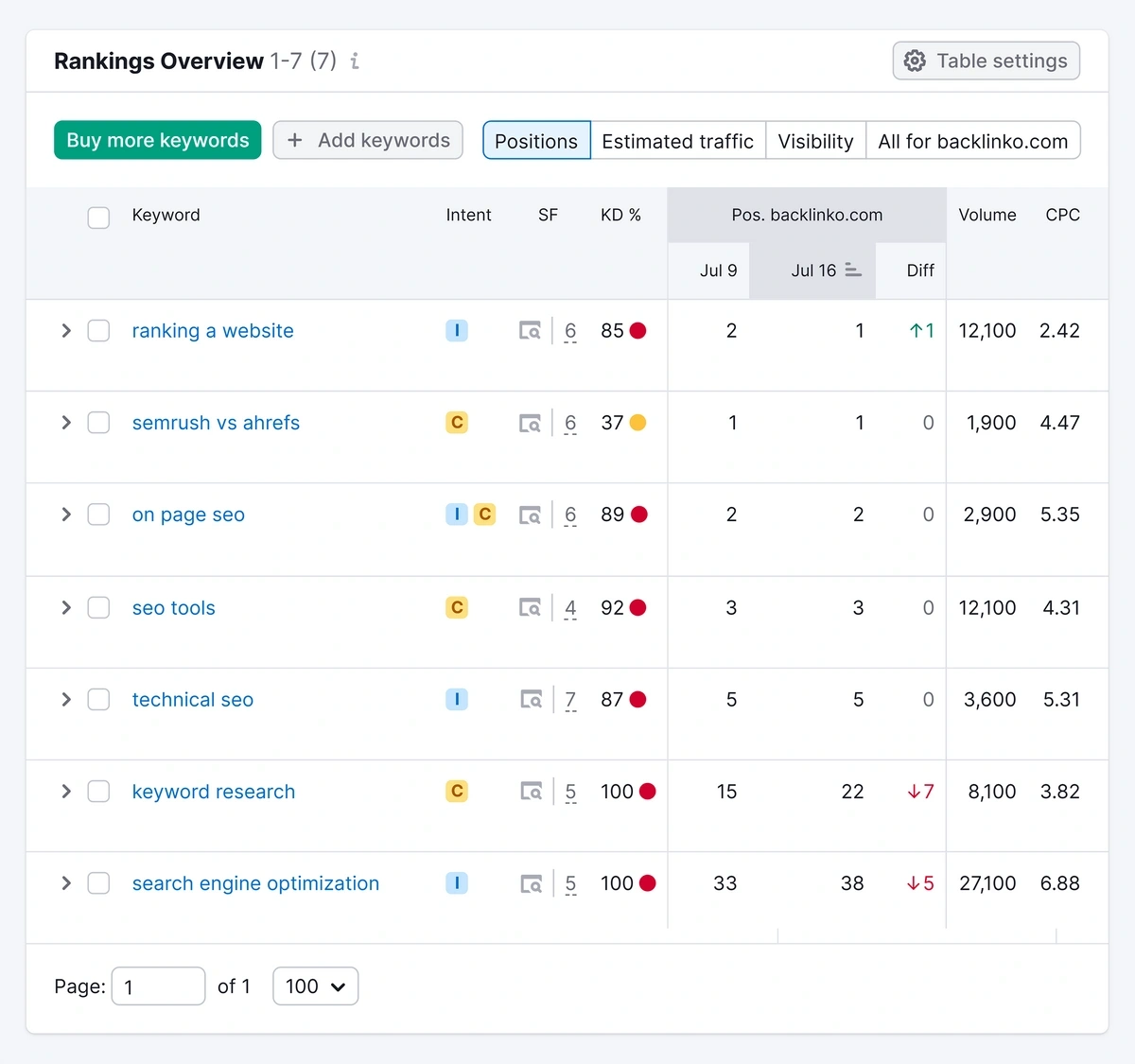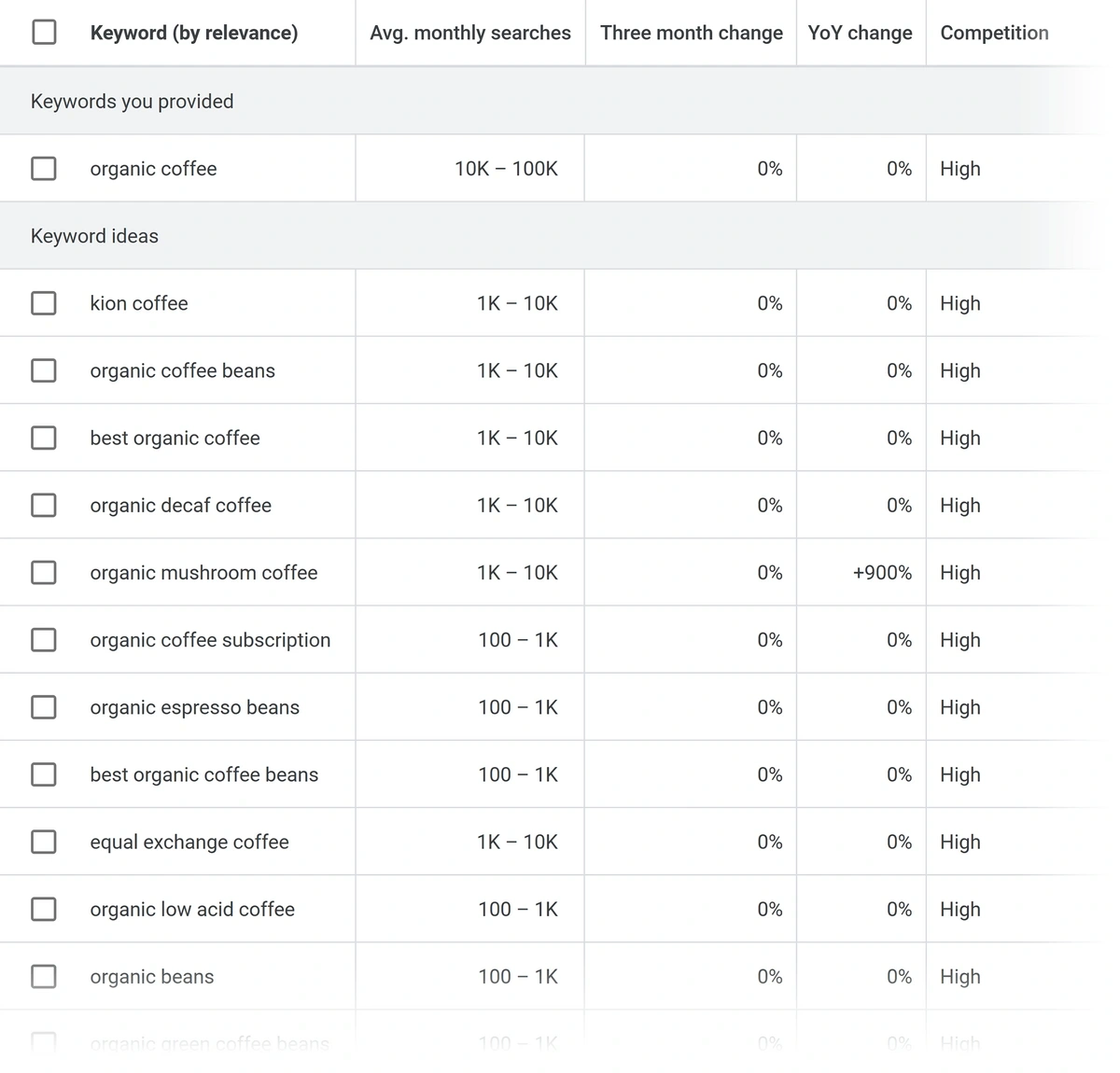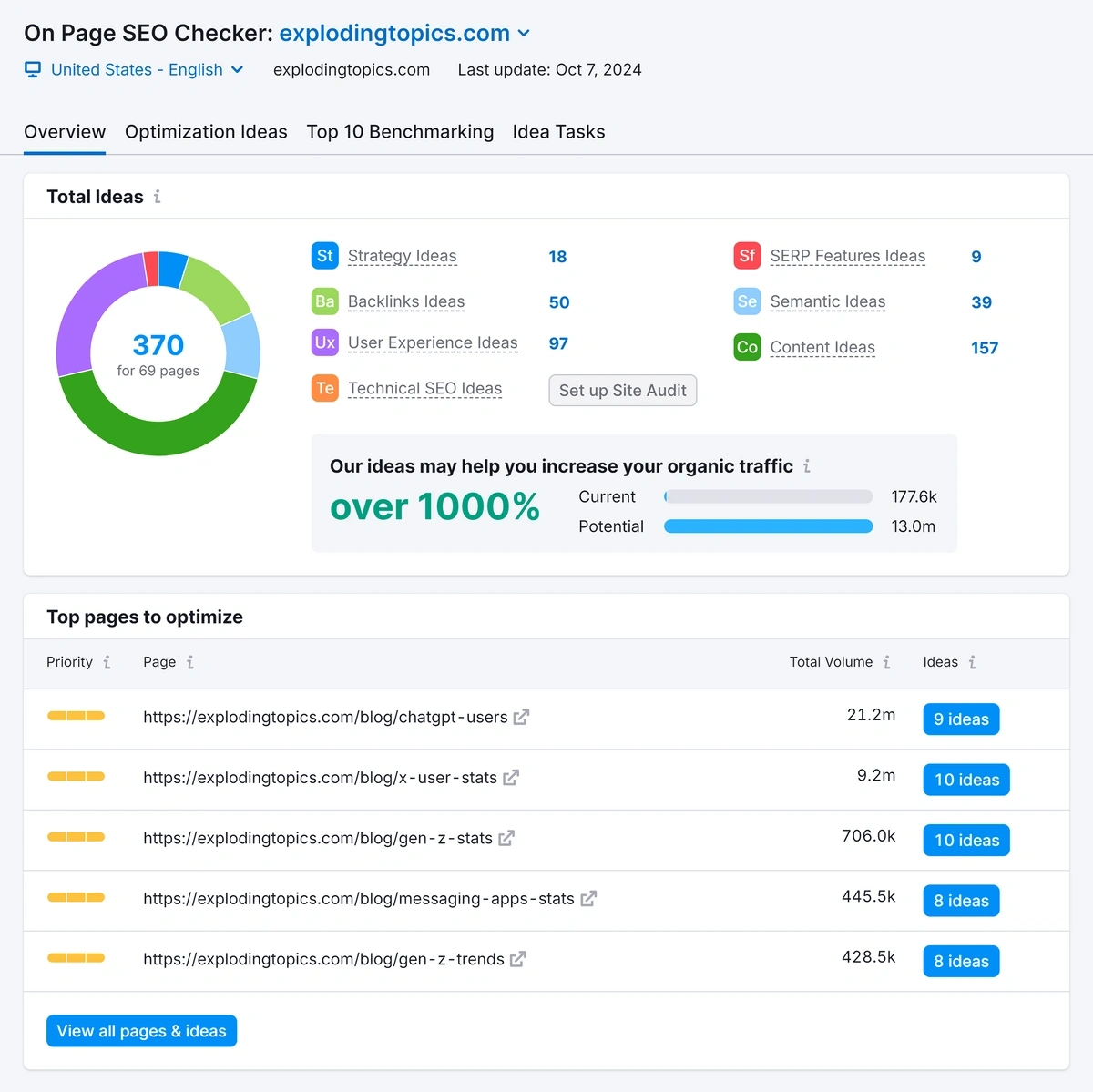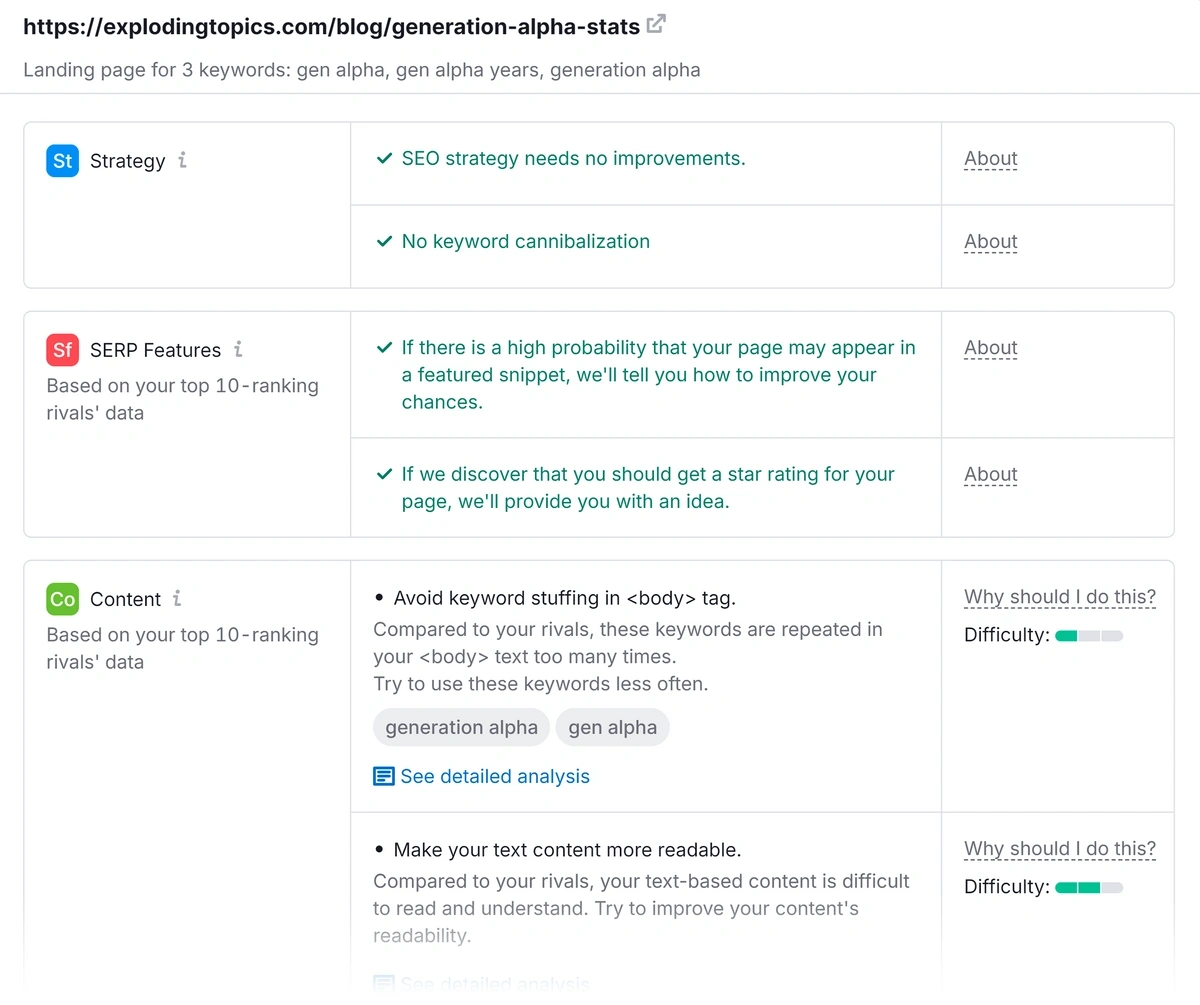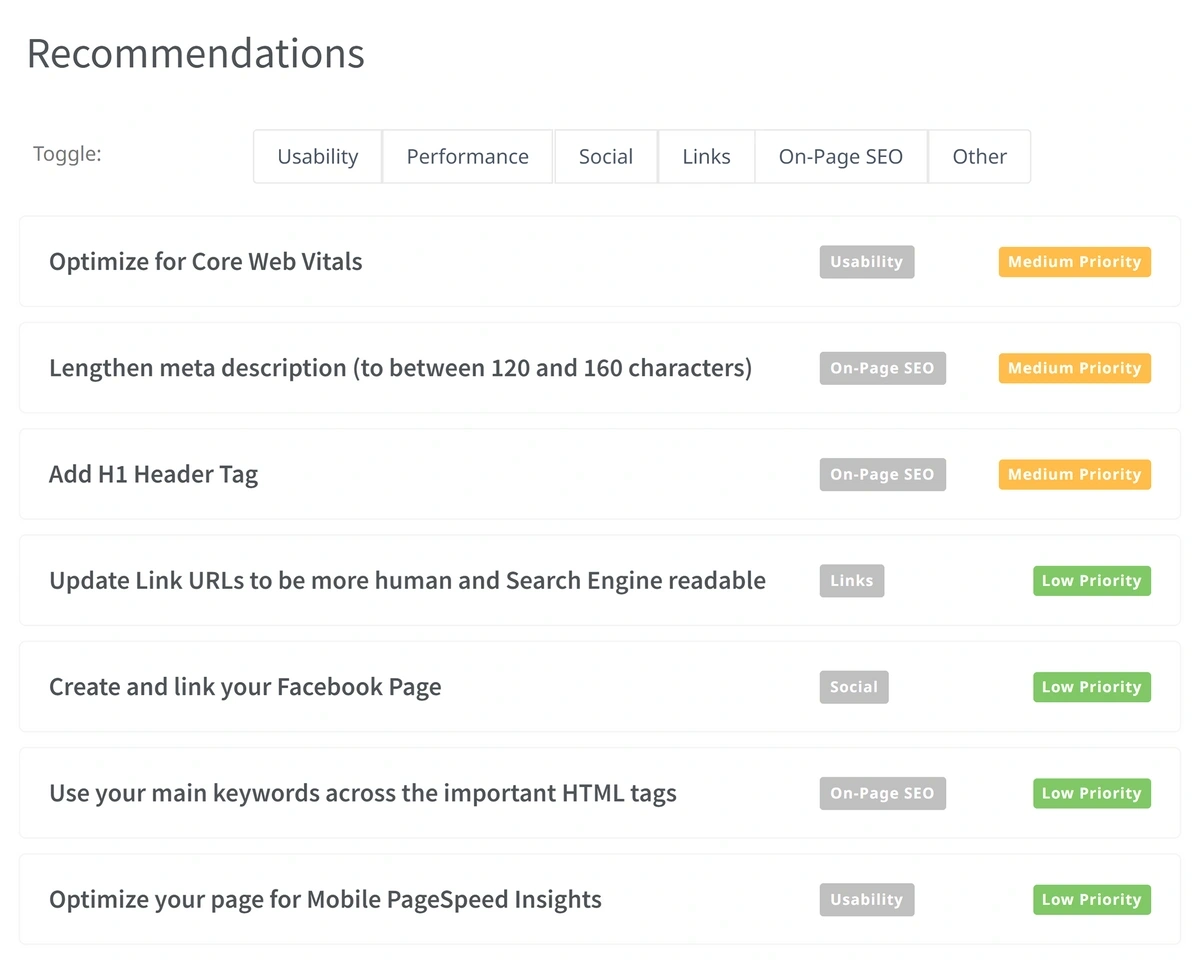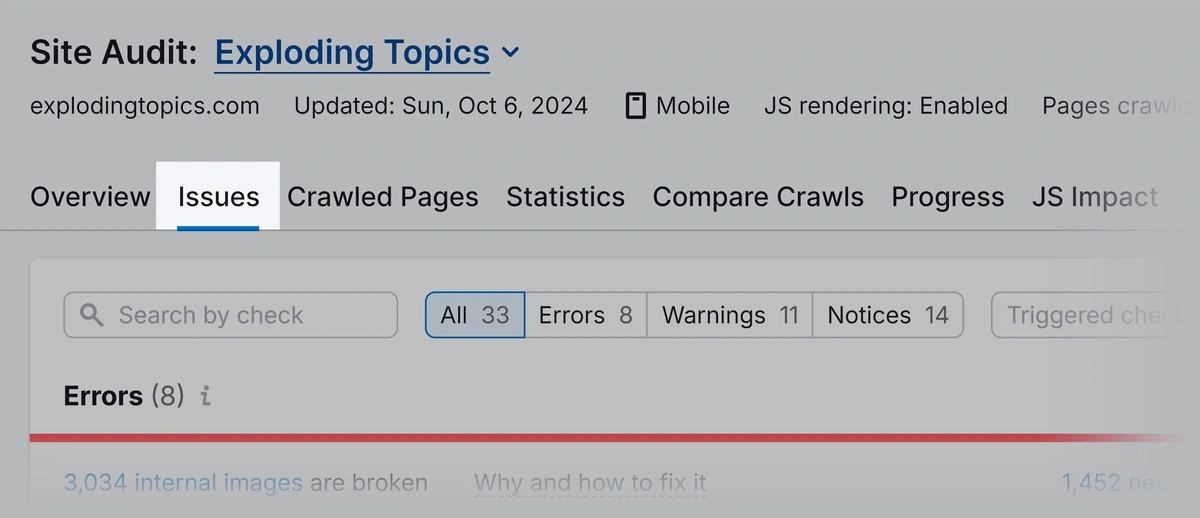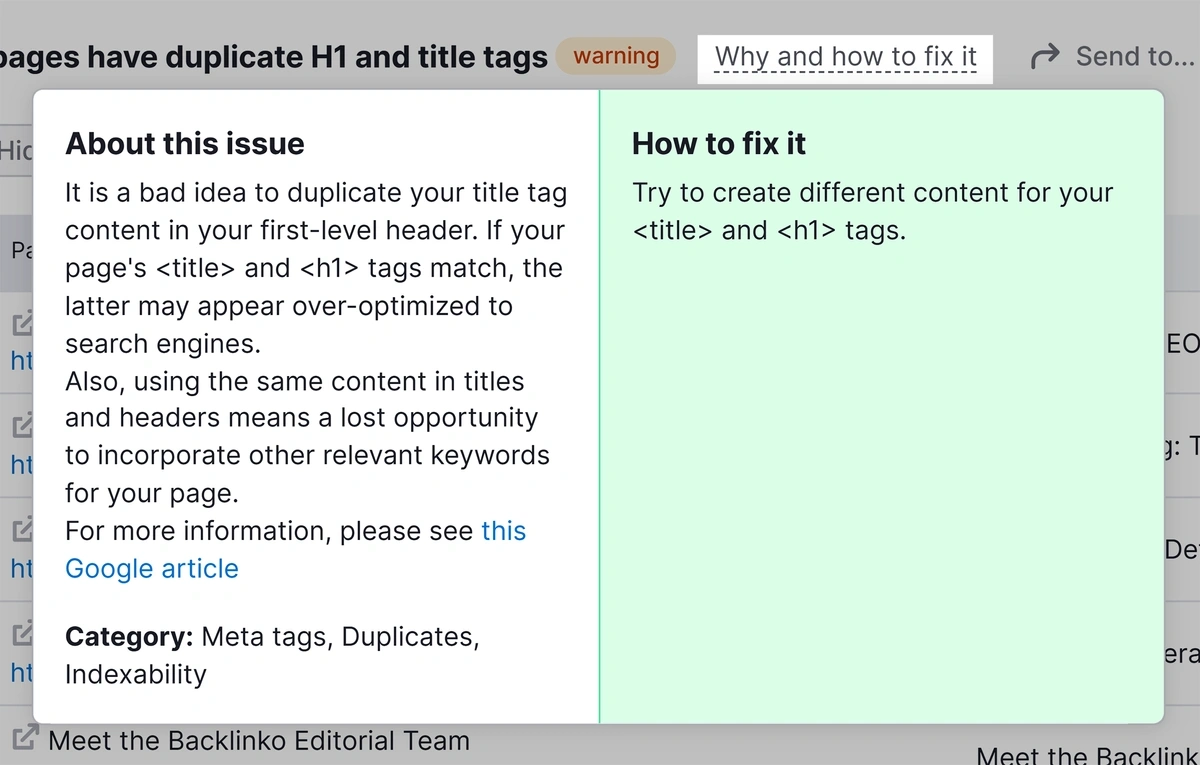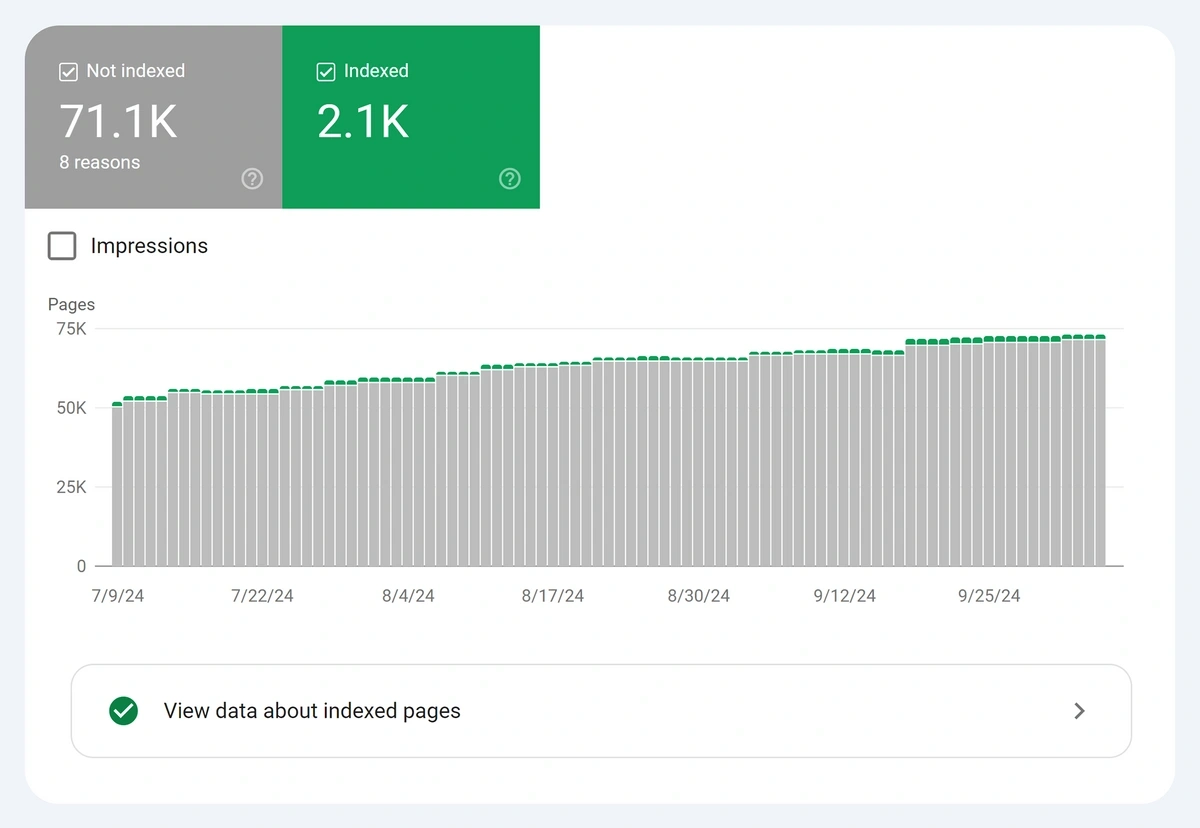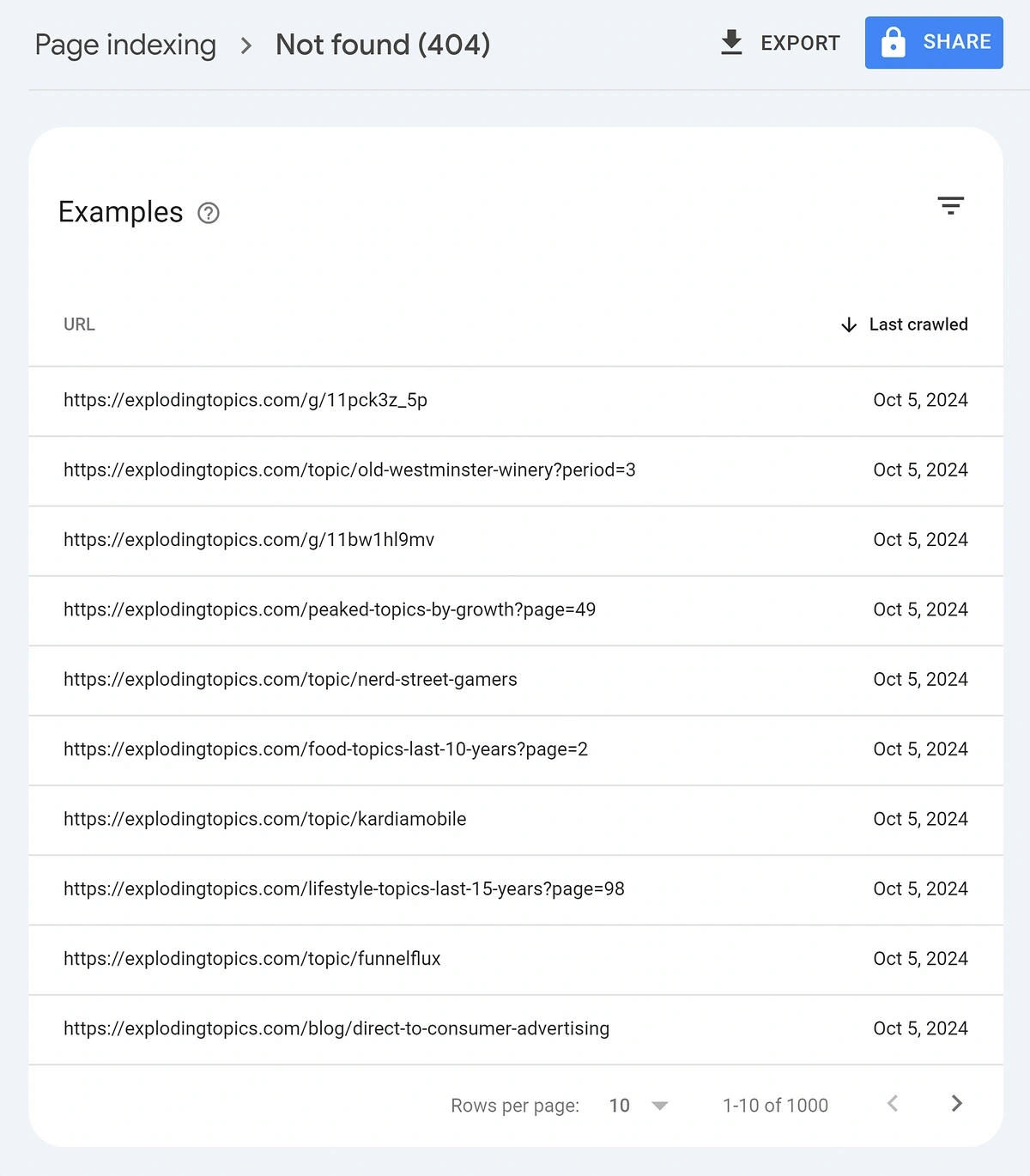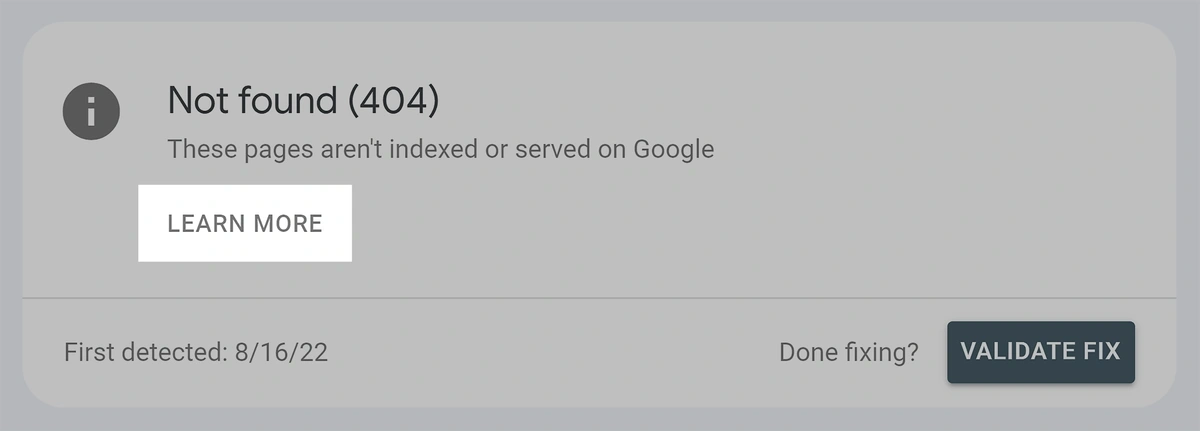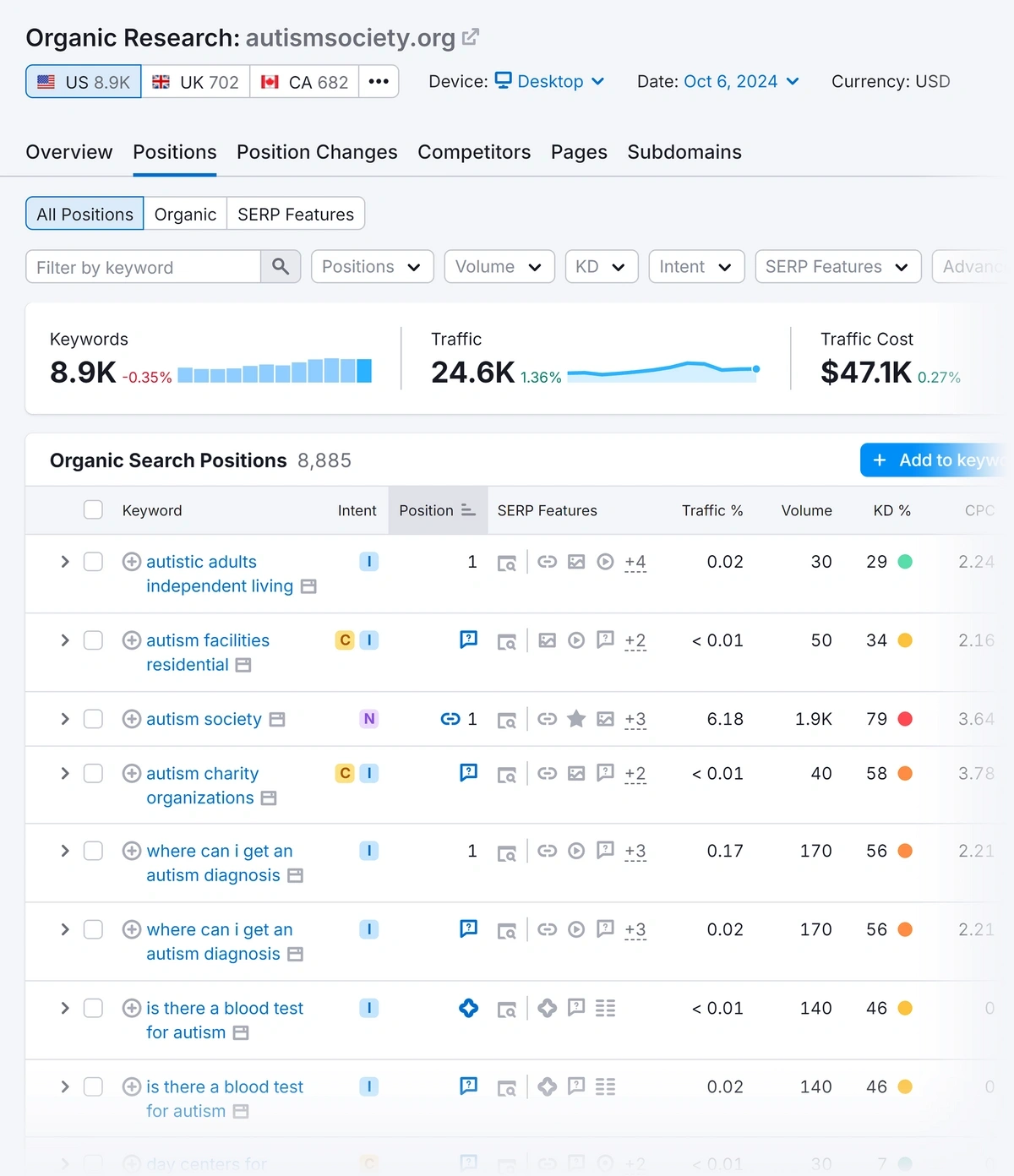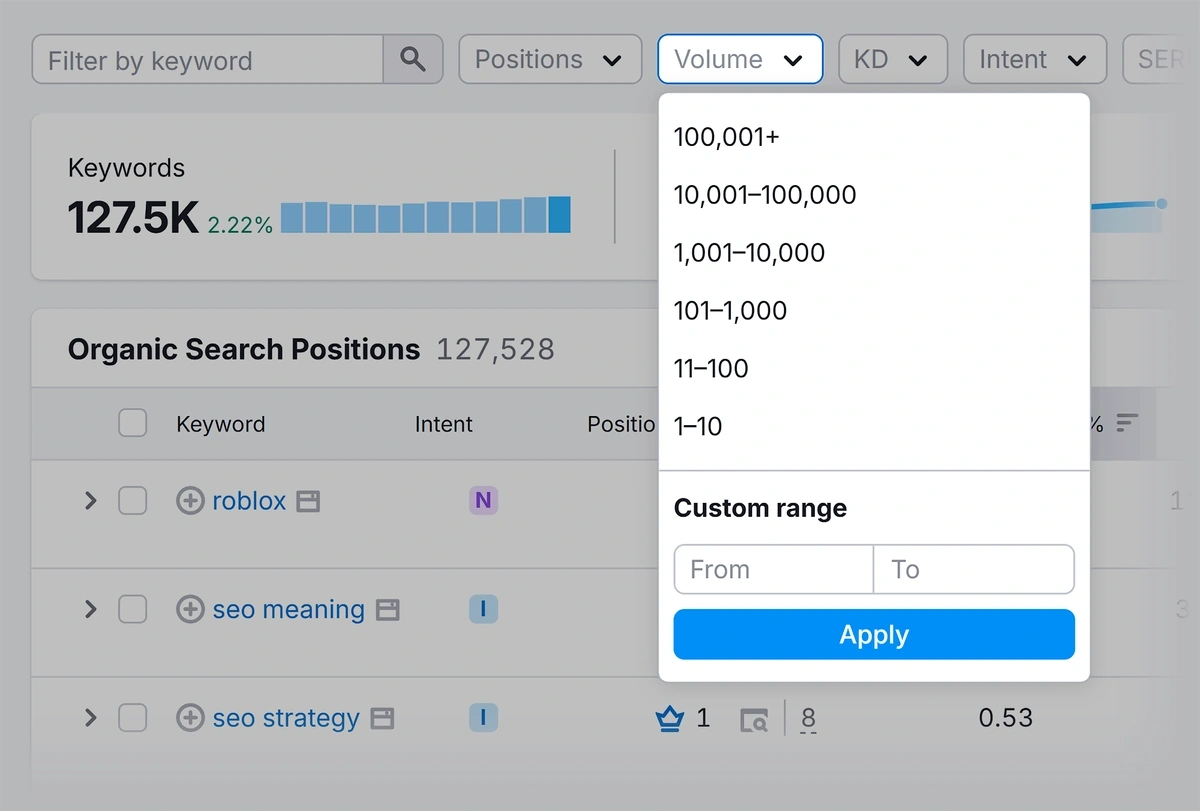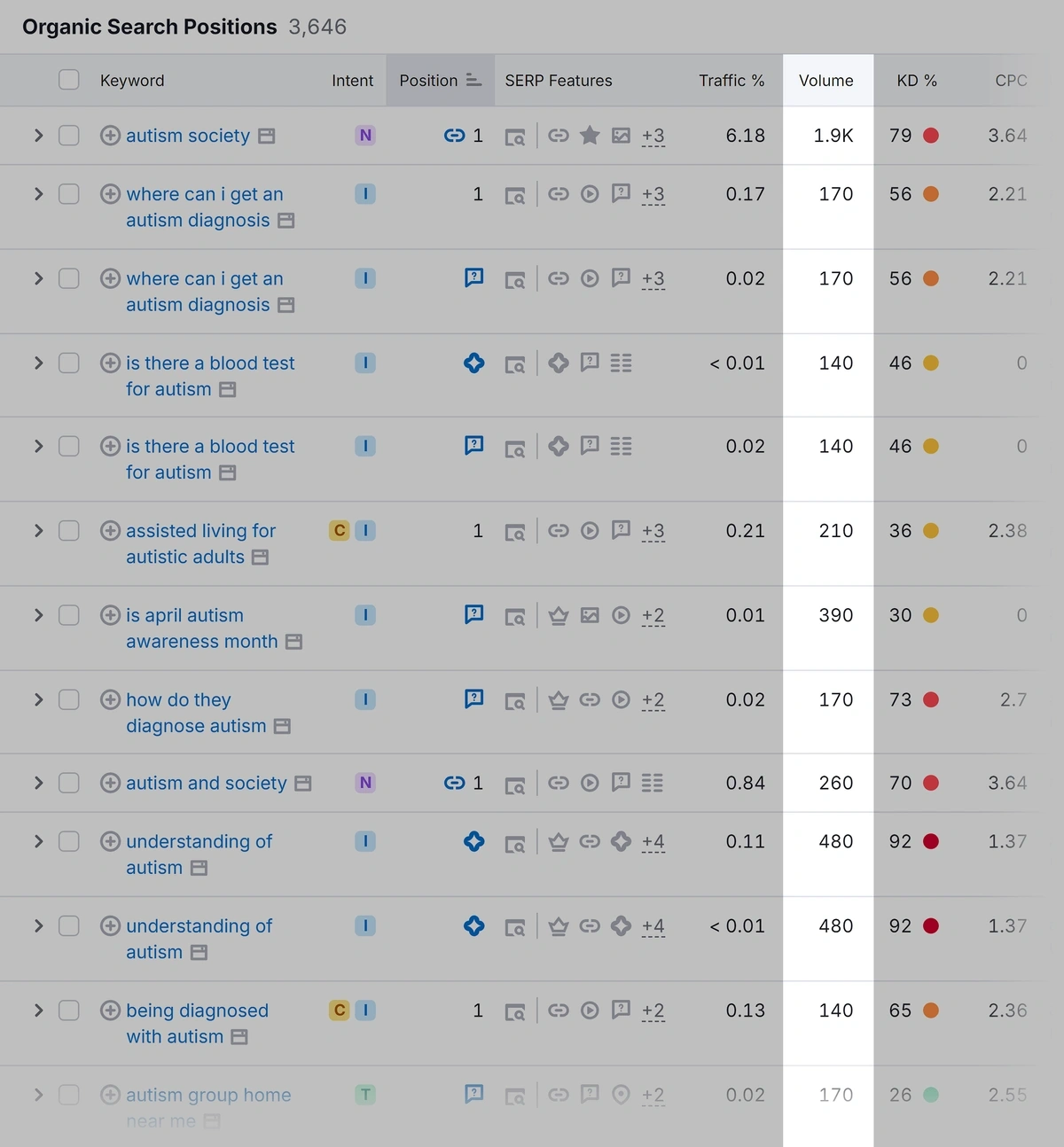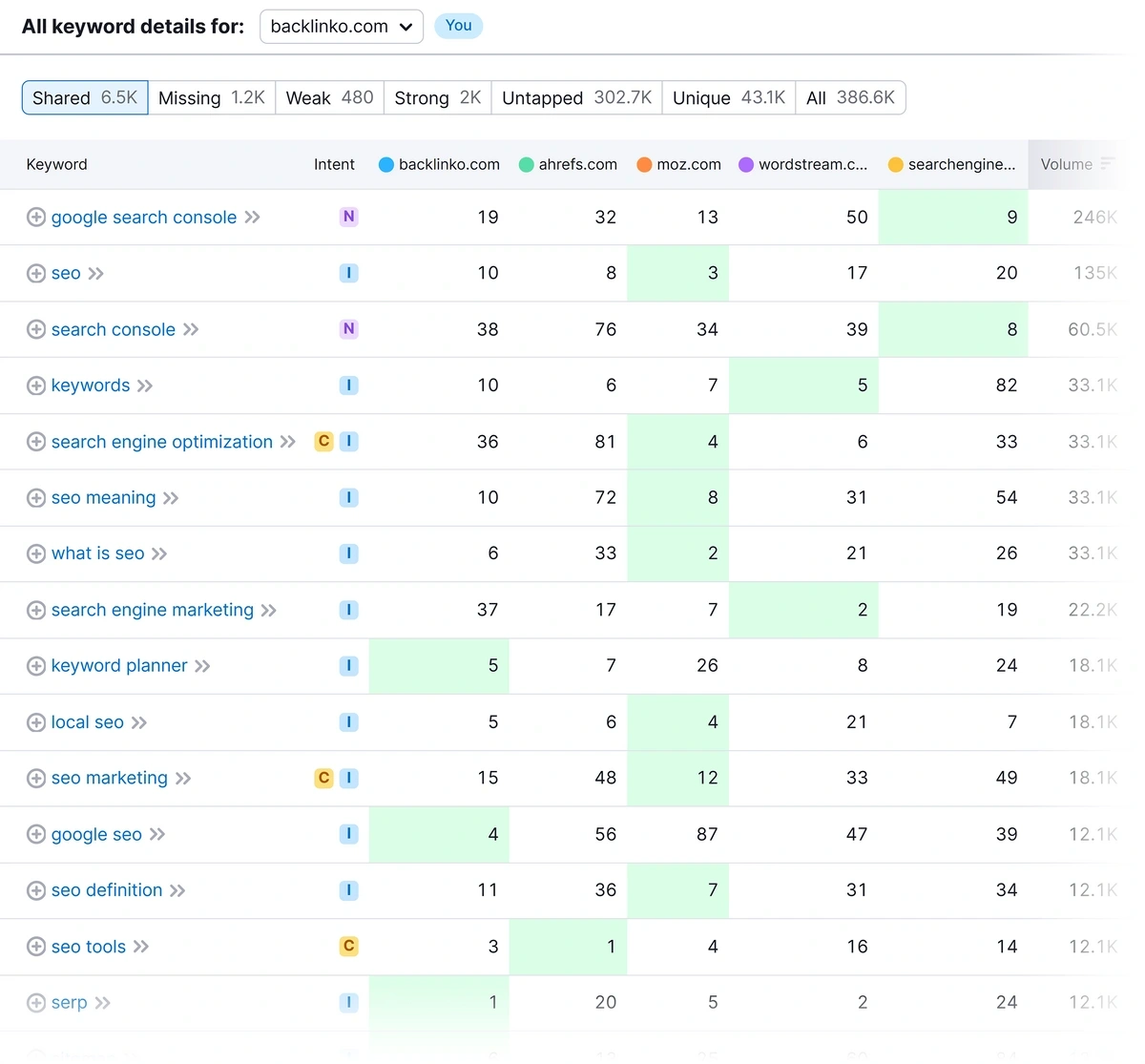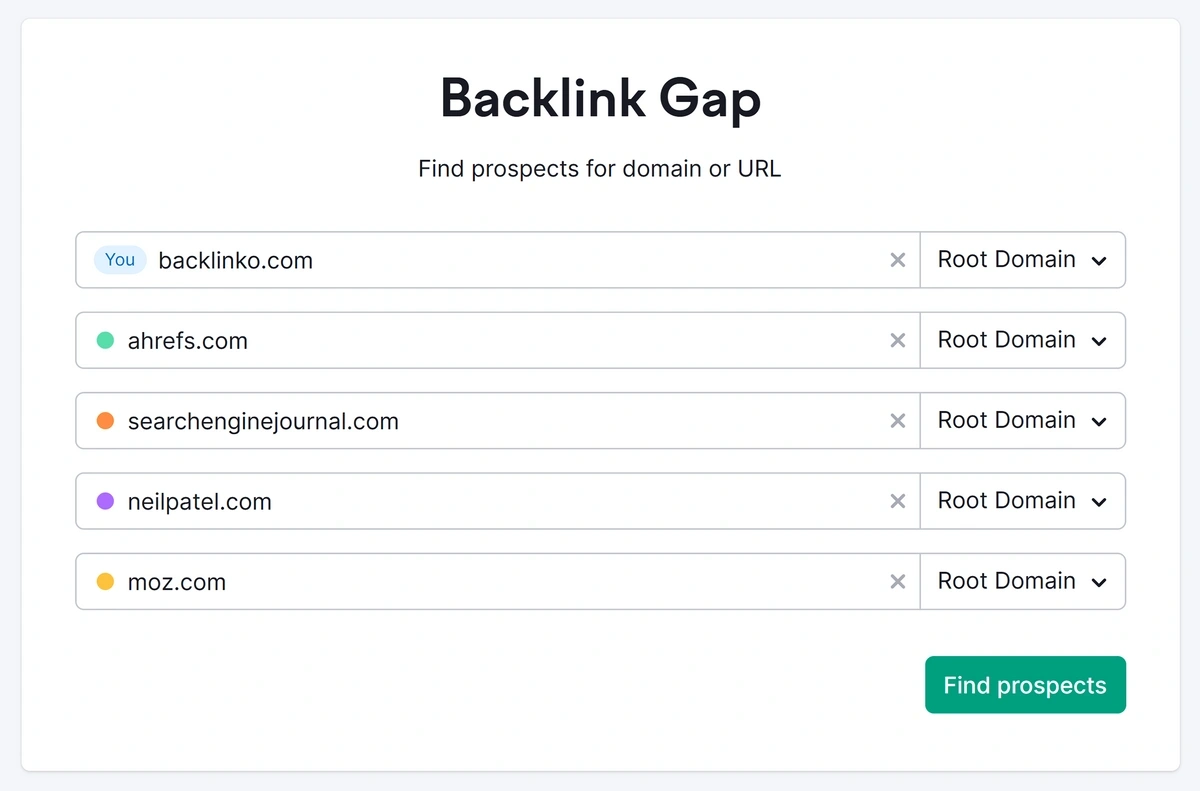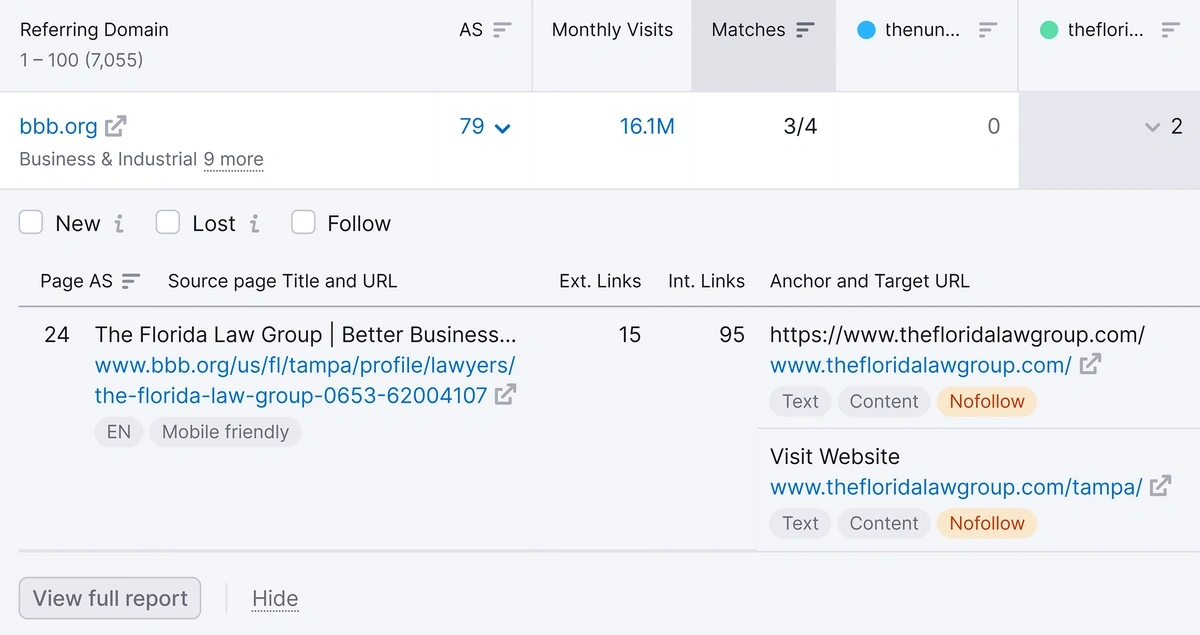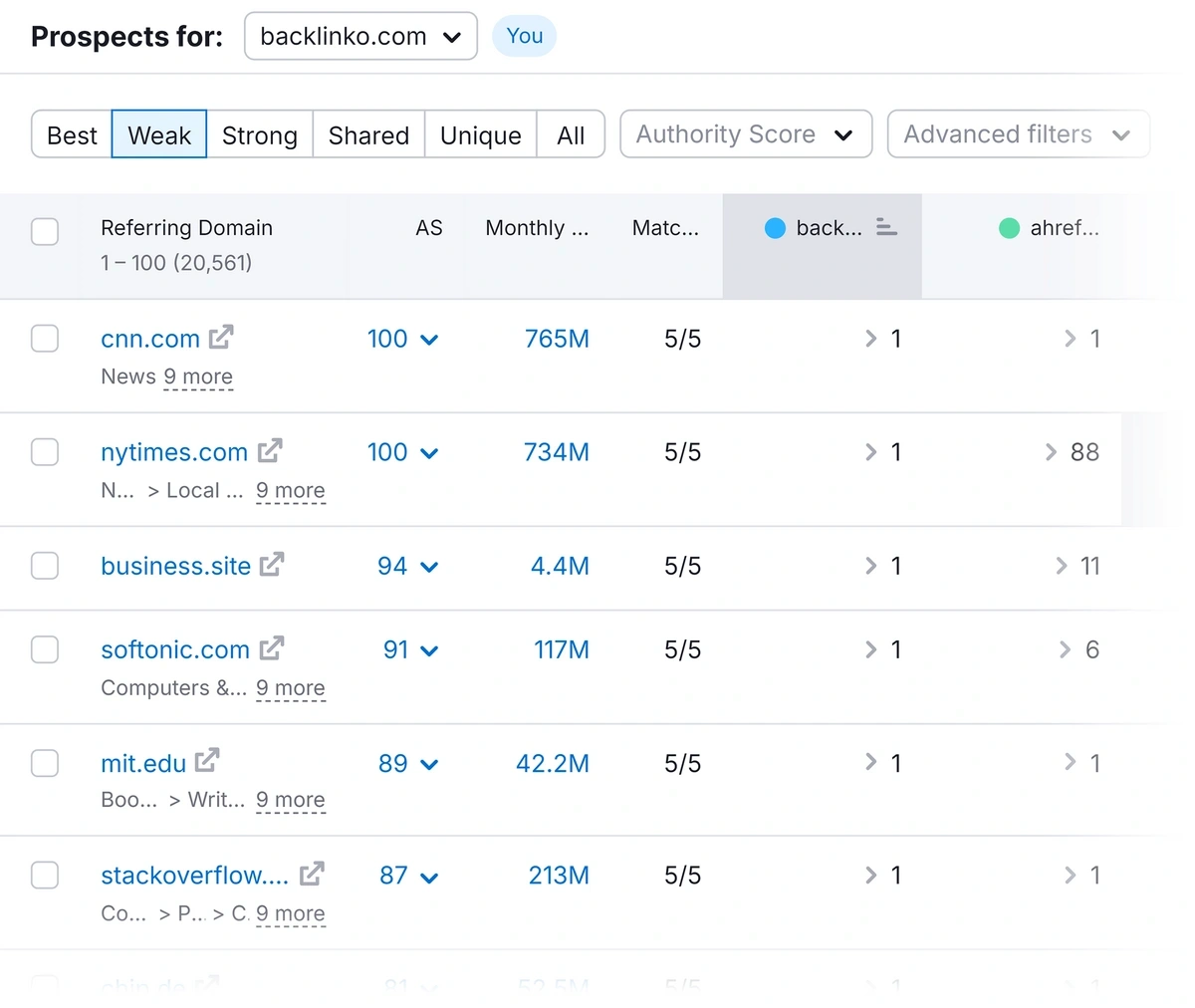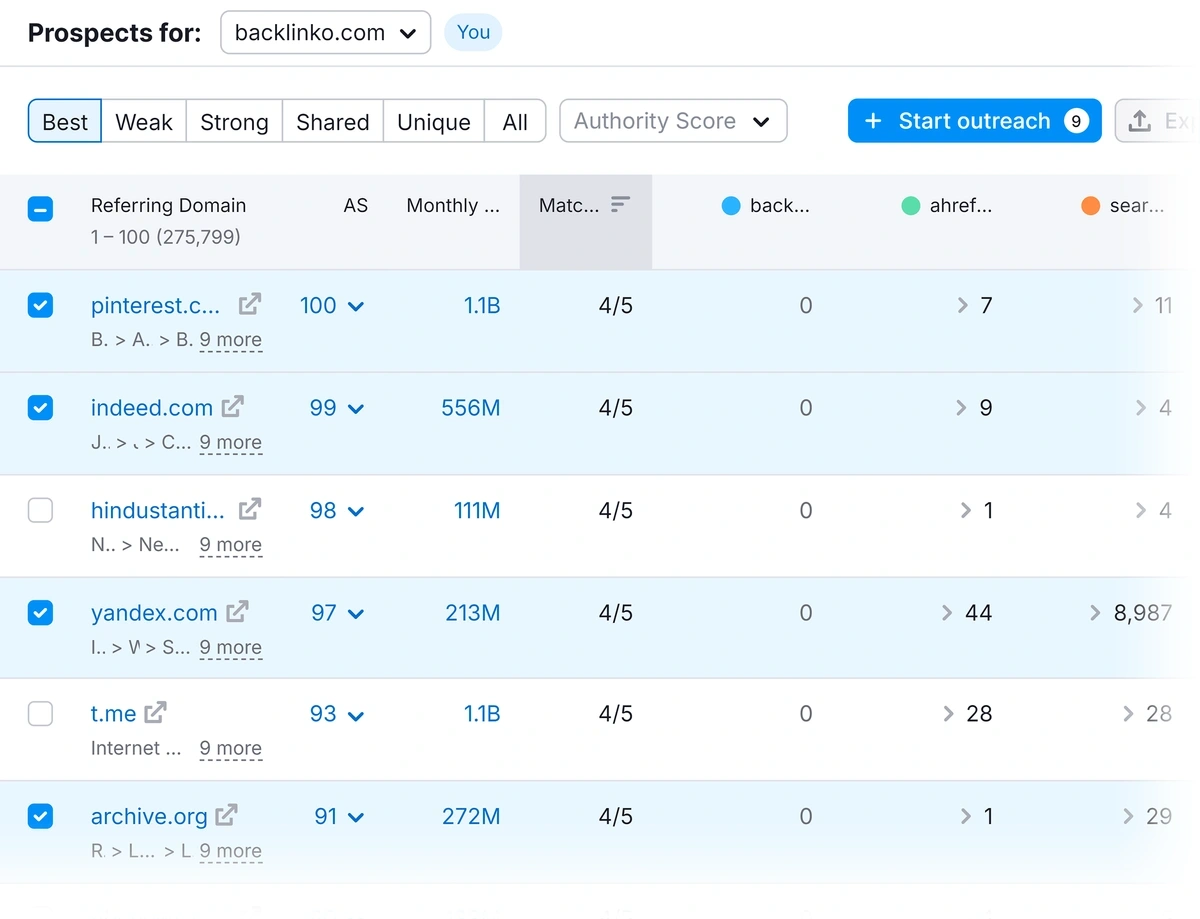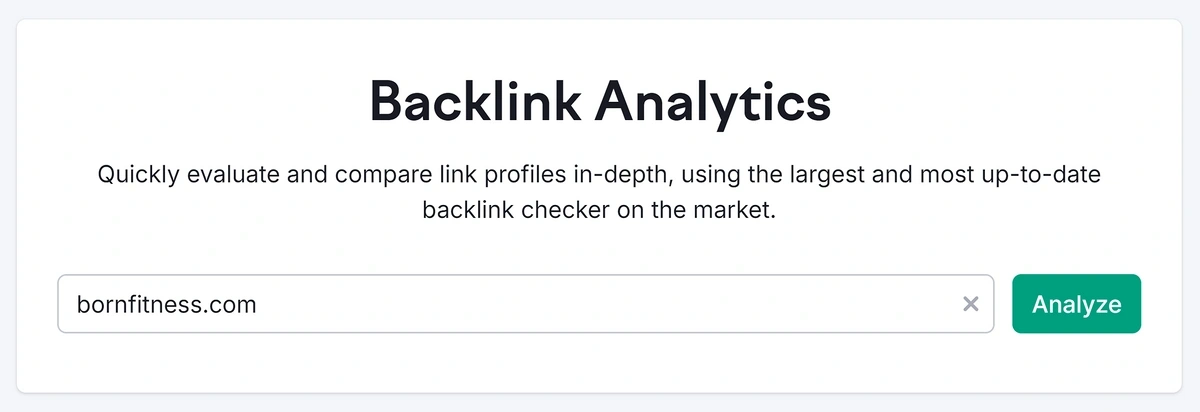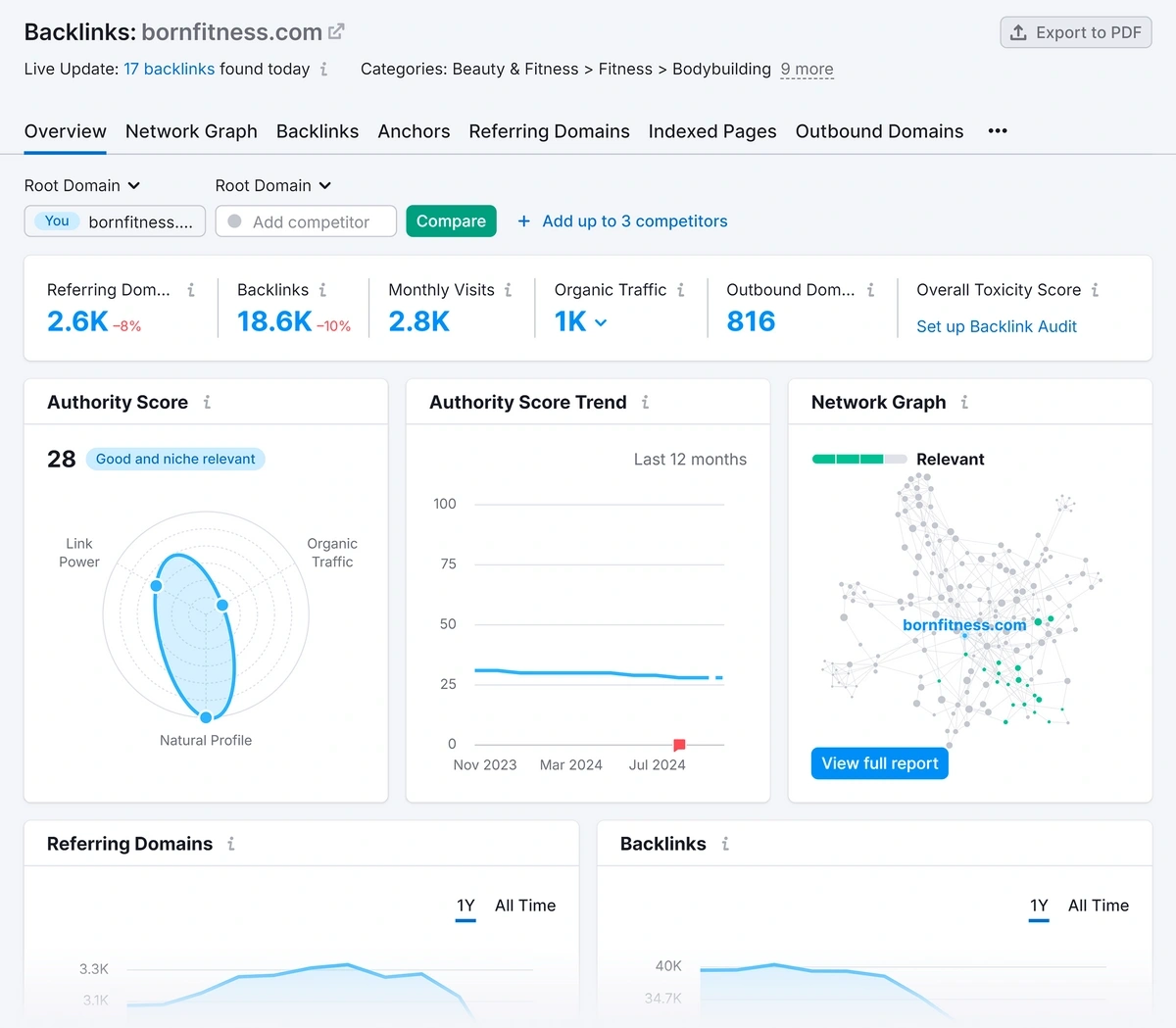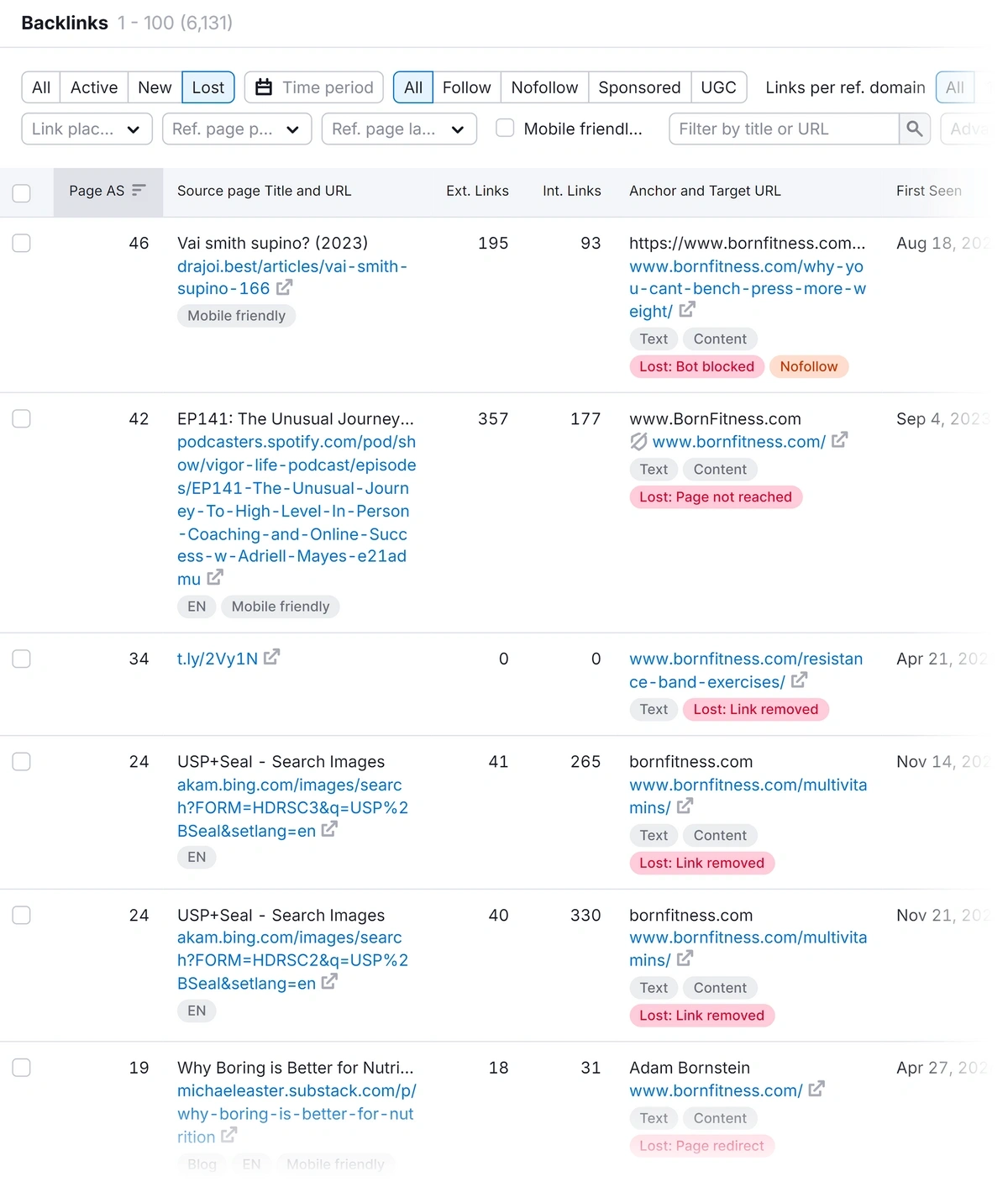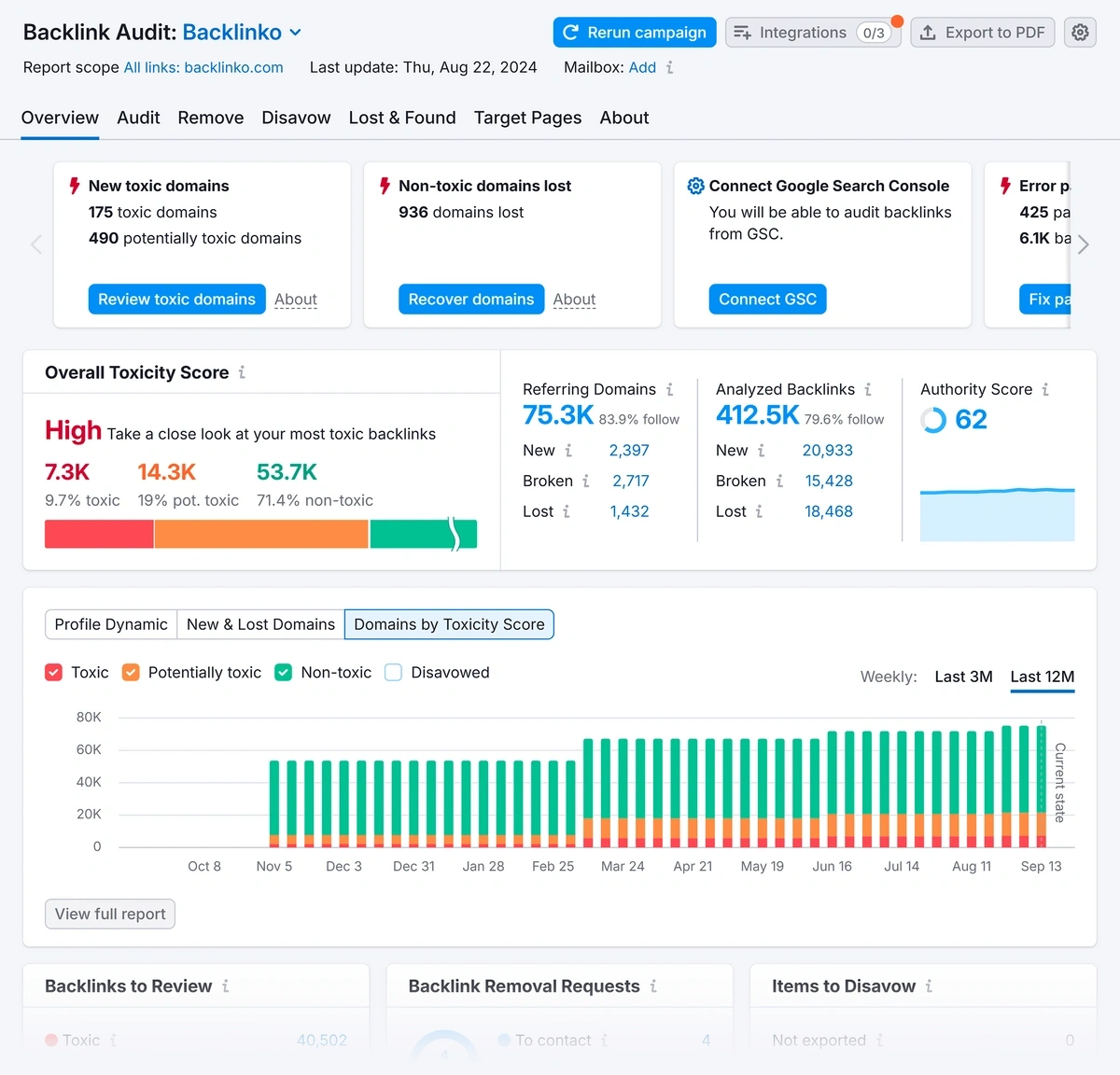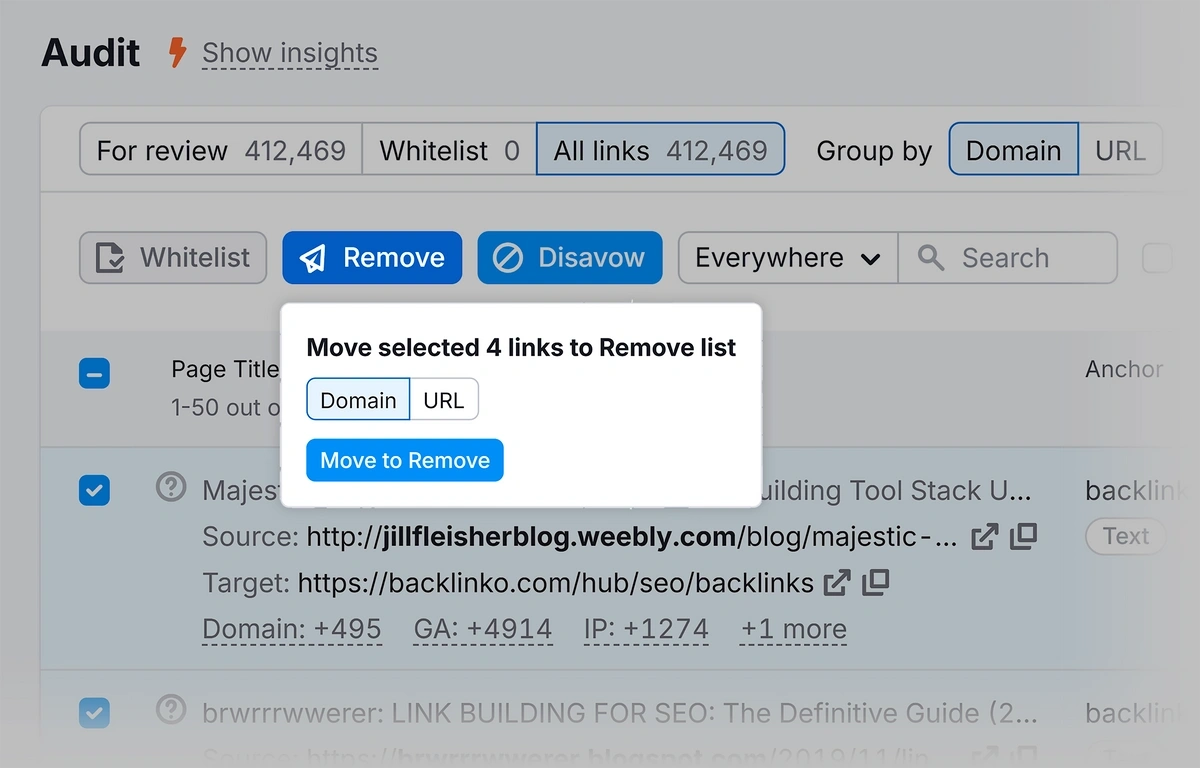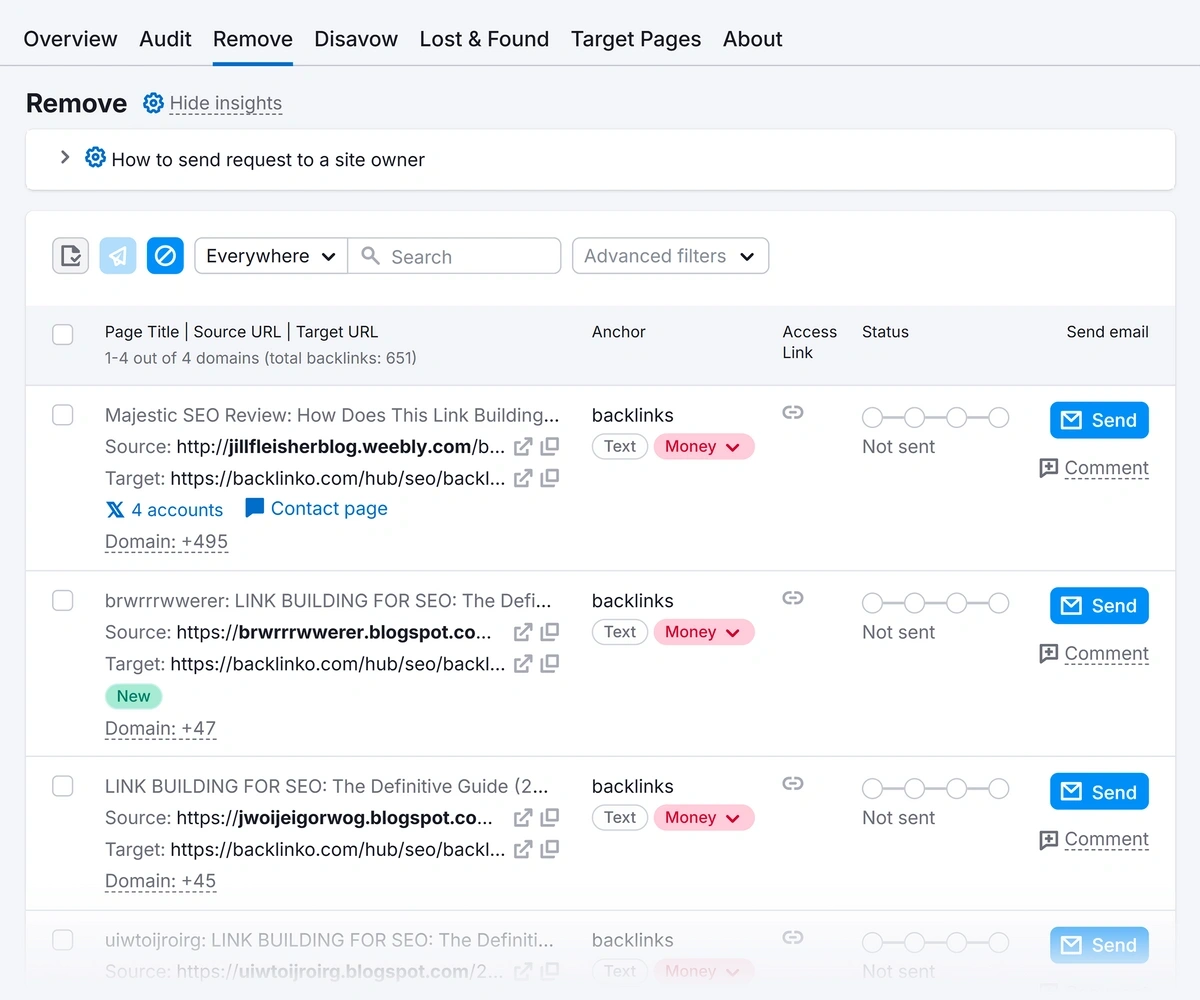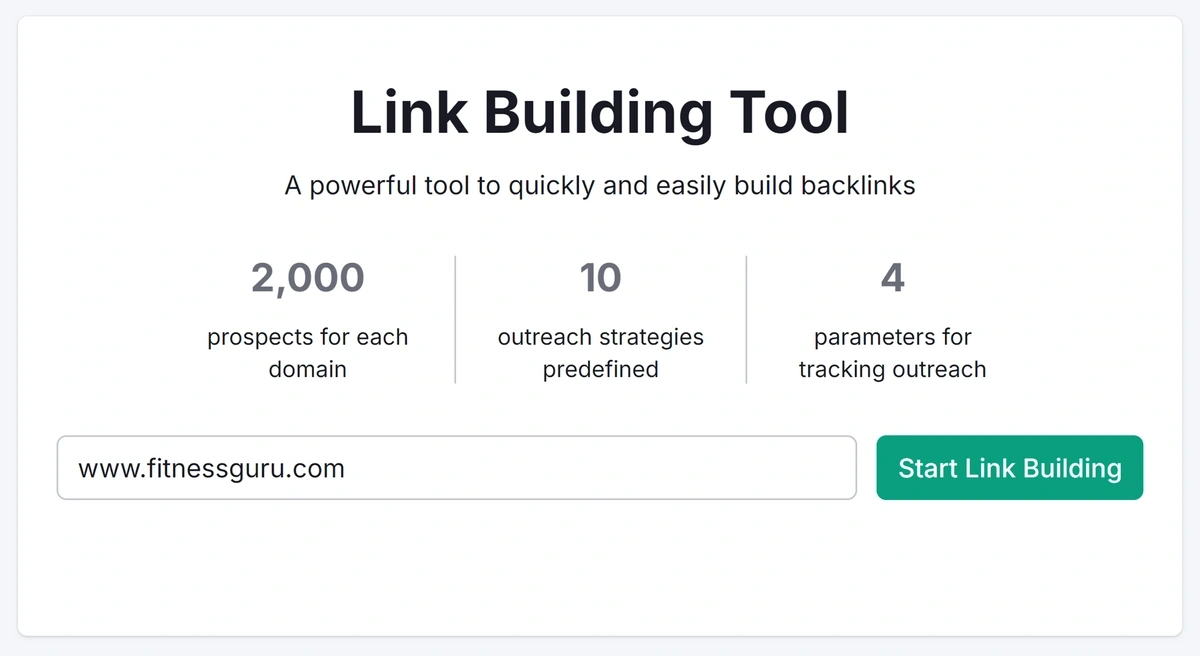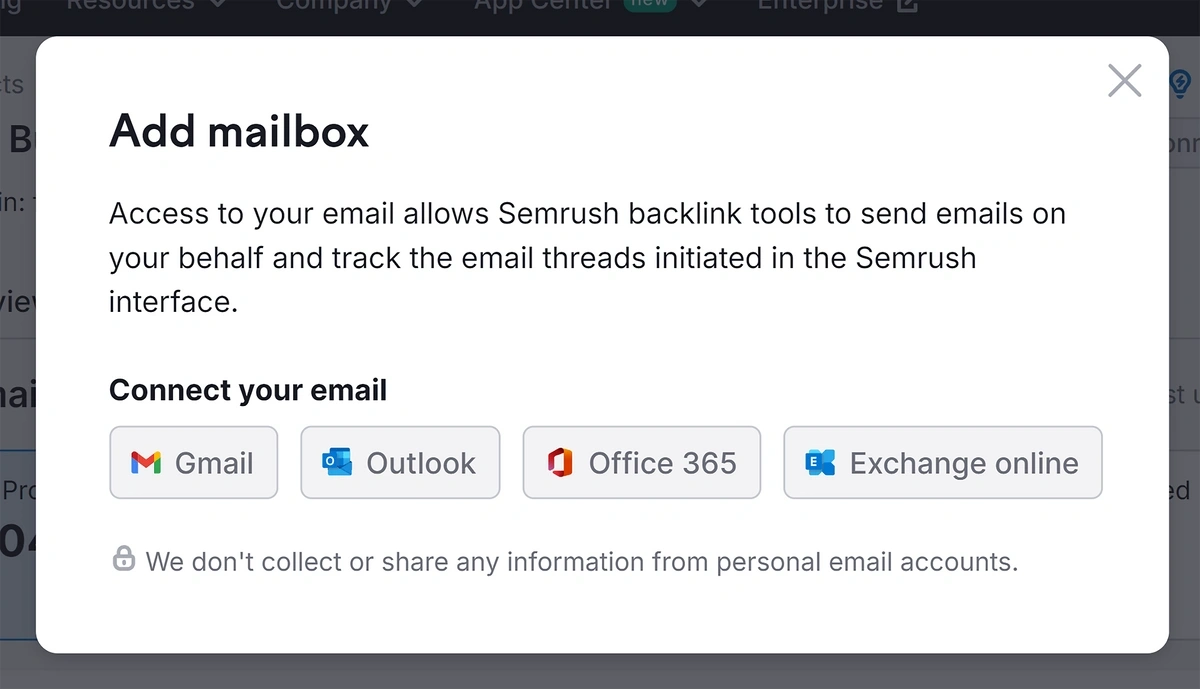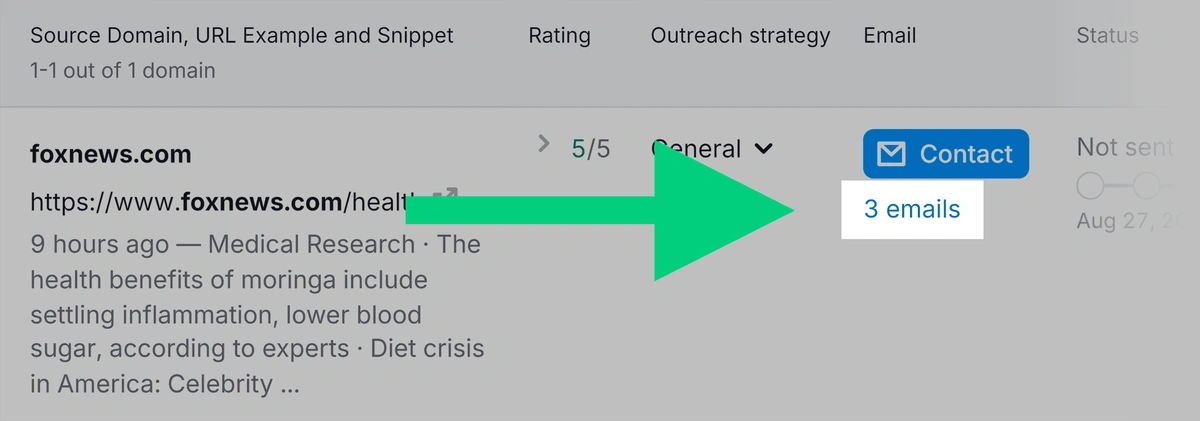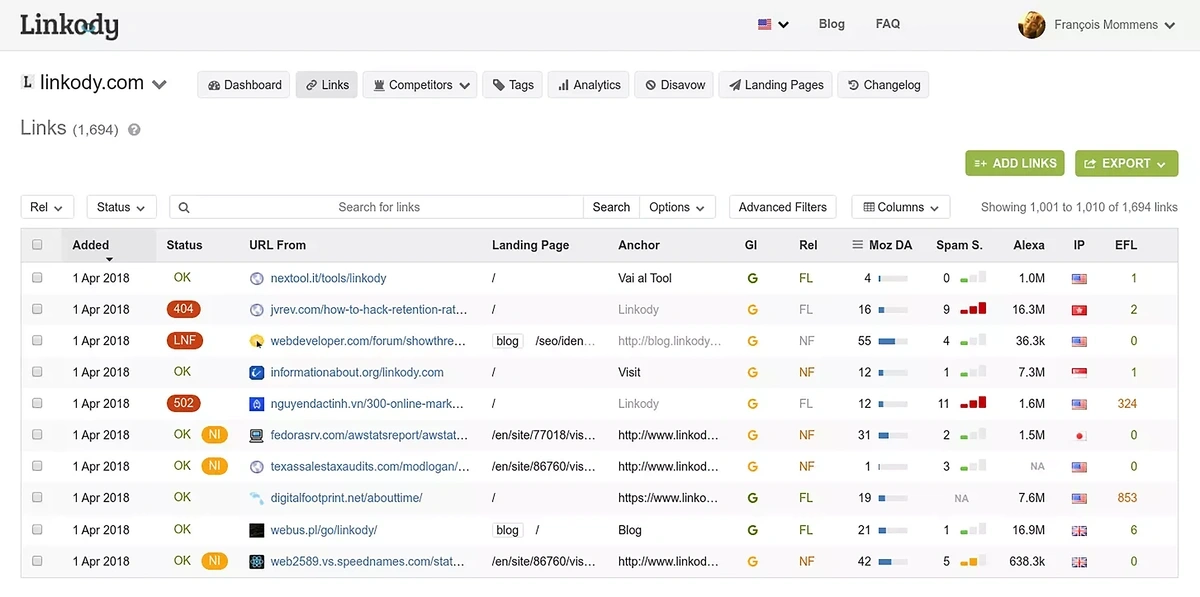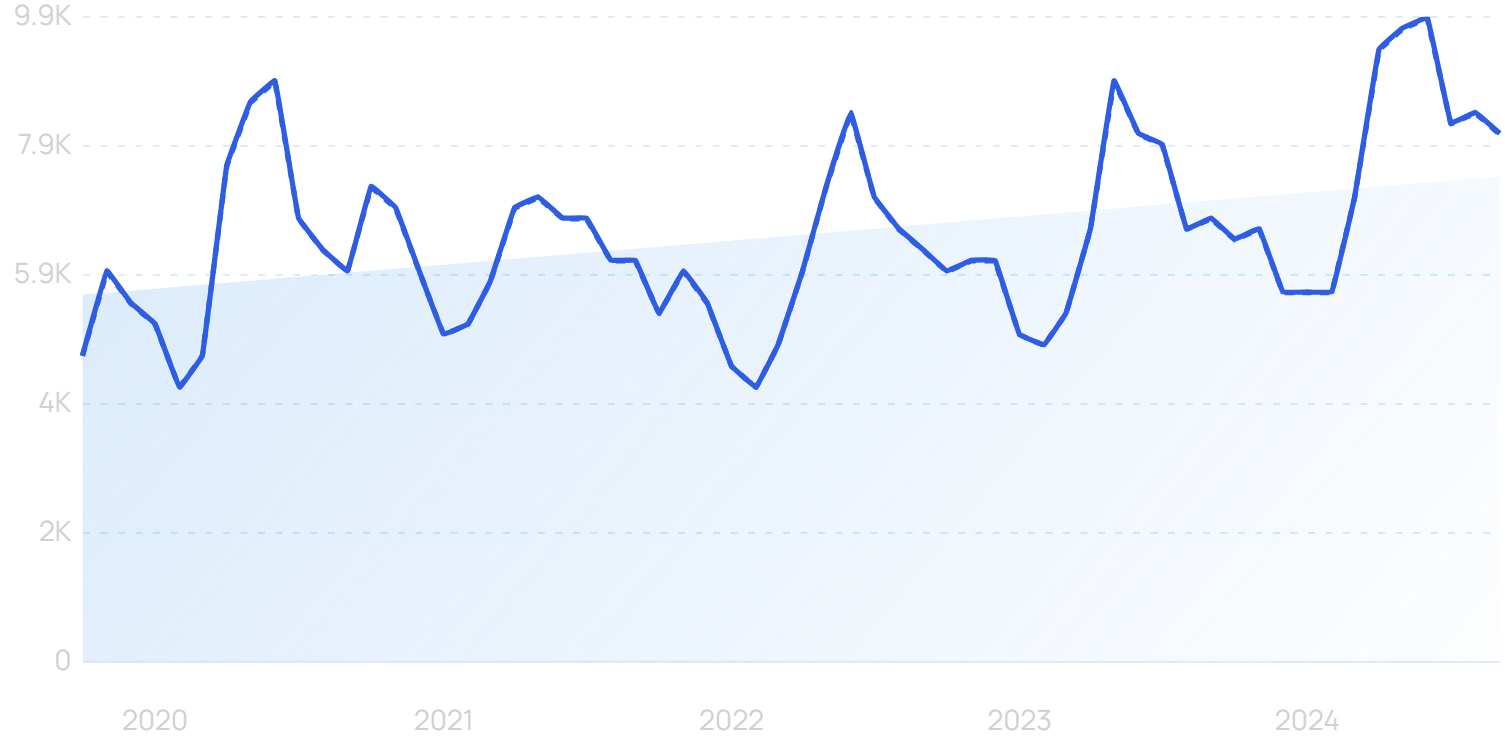
SEO tools can streamline getting your website to appear higher in search results.
There are tools to help with every stage of the process, from competitive analysis to content creation, and much more.
Because there are so many to choose from, we organized the available options into five categories:
Read on to learn which SEO tools can help you achieve the best results.
Pro tip: Create a free Semrush account (no credit card needed) so you can try out the Semrush tools described in this guide.
Semrush’s Keyword Overview tool provides in-depth data on search terms.
If you've already used the Exploding Topics free keyword research tool, you'll be familiar with the way Semrush works.
Our SEO tool shows you instant keyword insights. Semrush goes much deeper.
It can analyze up to 100 keywords at a time, helping you prioritize which terms to focus on.
In the “Overview” tab, you will see relevant metrics for each keyword:
Next, enter your domain name in the “AI-powered” bar to get a Personal Keyword Difficulty score.
This score measures how hard it will be for your specific website to rank well for that keyword.
To evaluate multiple keywords at once, go to the “Bulk Analysis” tab and enter your additional terms.
This allows you to compare terms side by side. You can then pick which keywords you want to focus on.
Some things to consider when looking at a keyword:
If the answer to both of these questions is “yes,” the keyword will drive traffic, and you stand a good chance of ranking for it.
Click the checkbox next to each term you want to save, then:
You can then review, add to, or remove terms from this list. You can also send your list to other tools, such as Semrush’s Keyword Strategy Builder.
Semrush's Keyword Magic Tool draws on a database of over 25 billion search terms to help you find keywords in your niche.
To get started:
The Keyword Magic Tool will generate a list of keywords that includes your starting keyword and close variations.
For each keyword, you’ll see:
From the top menu, you can filter the results by keyword match types, search volume, language, and other criteria.
(Keyword match types are important if you're running a Google Ads campaign.)
To narrow the list, use the filters to set a volume range of 100 searches or more per month, and a Personal Keyword Difficulty score of 49 or less.
You can also use the “Questions” tab to show a list of question keywords.
Question keywords often don’t get as many monthly searches, but they tend to attract more qualified traffic.
Again, you can use the checkboxes to create or add keywords to a list.
Further reading: Keyword Research for SEO: What It Is & How to Do It
Semrush's Position Tracking tool shows target keyword performance and tracks changes over time.
To get started, enter your domain name in the designated field and click “Set up tracking.”
Next, follow the prompts to configure the tool and add your target search terms.
You can add keywords manually or import them from various sources, including:
When you're done with the setup, click "Start Tracking."
Once the tool collects data, review the default "Landscape" tab.
You'll see the following keyword performance metrics for your website:
Click the "Overview" tab to see how performance has changed over a specific time period.
You can focus on different metrics by selecting the button for each one: Share of Voice, Visibility, Est. Traffic, and Avg. Position.
Scroll down to “Rankings Overview” to see rankings for each keyword.
You can also see how rankings have changed since the last time period, as well as other metrics.
Leverage this data to fine-tune your keyword strategy and website copy.
For example, you can update content focused on low-ranking keywords to get more traffic.
Further reading: How to Track SERP Rankings with the Semrush Position Tracking Tool
Google’s Keyword Planner is primarily for paid search, but it can also be used to find SEO terms.
You can access Keyword Planner from your Google Ads account.
To use the “Discover new keywords” option:
Keyword Planner will list keywords related to the terms you provided.
The tool also provides relevant data for each keyword:
You can use filters and the “Refine keywords” menu to narrow your results and choose keywords relevant to your website.
Once you have a list you like, you can export it by choosing “Download keyword ideas” in the top right corner. You can then import that list into another tool like Semrush.
Note: This tool has a steeper learning curve than some other free SEO tools. See this guide on how to use Google Keyword Planner.
Semrush's On Page SEO Checker analyzes your web pages to uncover areas for improvement.
The checker provides suggestions related to content, link building, user experience (UX), and more.
Start by configuring the tool for your domain.
Once the setup is complete, review the "Overview" report to analyze the ideas and their potential impact.
On Page SEO Checker will make recommendations for specific on page SEO elements that may need attention, such as:
Where no recommendations are needed, the checker will provide a green checkmark and explanatory text.
As you implement changes, use the "Idea Tasks" tab to monitor your progress.
Further reading: On Page SEO: What It Is and How to Do It
SEOptimer is an SEO audit and reporting tool.
It checks your website for issues across five main areas:
For example, it detects missing title tags, poor keyword use, thin content, etc.
Where it finds potential issues, the tool provides high-, medium-, and low-priority recommendations for improvement.
Each section of the audit includes clear explanations and suggestions for improvement.
Semrush's Site Audit tool scans a website for technical issues and provides guidance on how to address them.
For starters, configure Site Audit and let it crawl your domain.
Once the audit is complete, click the "Issues" tab to see a list of specific problems affecting your website.
This page displays:
First, check the technical issues listed under "Errors."
Click "Why and how to fix it" next to any issue to find out what it means and what steps you can take.
Click the error itself to see which pages contain that error.
Address each issue one by one to improve your site’s SEO and UX. Start with the errors first, then work your way through the warnings and notices.
Further reading: How to Perform a Technical SEO Audit in 10 Steps
Google Search Console (GSC) monitors website performance in search results.
It can also detect technical SEO issues, such:
The "Overview" page supplies a high-level look at a website.
In the “Page indexing” report, you can see the number of pages Google has indexed on your site.
Scroll down to see why some of your pages aren’t indexed. Reasons may include:
There are many potential reasons why a page might not be indexed. Note that it is common for some pages on a website not to be indexed.
Click on each issue to see the affected pages.
There’s a "Learn More" button you can use to gain a better understanding of a given problem.
GSC also enables you to:
Further reading: Google Search Console Errors: Identifying and Fixing Them
Semrush's Organic Research tool lets you analyze competitor keyword rankings.
You can also check competitors’ top pages and the estimated amount of traffic they receive.
To start:
Next, click the "Positions" tab to see a list of the competitor’s ranking keywords.
The table will provide:
Evaluate the list to see whether there are keywords your website should target.
To find options that have a decent number of monthly searches:
This refines the list to show only keywords with at least 100 monthly searches.
Look at relevant terms for which you can create content. If done right, you could outrank the competition.
Finally, click the "Competitors" tab to see who your main SERP competitors are.
This list could reveal competitors you don’t already know about!
Semrush's Keyword Gap tool lets you compare a website’s keywords against other domains:
Scroll down to the table.
On the “Shared” tab, you will see ranking keywords for each of the analyzed domains.
As for the other tabs:
Refine your content strategy to incorporate these opportunities and beat your competition in the SERPs.
Further reading: Keyword Gap Analysis: What It Is & How to Do It
Semrush's Backlink Gap tool lets you compare your backlinks to competitors.
Backlinks are links from other websites to your own. Backlinks from authoritative sources can indicate trustworthiness to visitors – and to Google.
Well-placed backlinks can also drive referral traffic.
To find backlink gaps:
Click “Best” at the top of the table to see websites that link to competitors, but not to your website.
By default, the list is sorted from highest Authority Score (a metric that indicates how reputable a website is) to lowest.
Those with the highest scores are likely to have the greatest impact on your SEO.
Click on the numbers under each competitors' domain to see backlinks from a specific source.
Open the source page to see where the backlink is located on the page, along with surrounding text.
You may be able to reach out to the website owner to ask if they would be willing to link to your content instead.
Other sections of the report provide additional information. For instance, "Weak" domains link to your competitors more often than they link to your site.
From any tab, check the boxes next to the domains you’re interested in contacting. And click "+ Start outreach" to send them to Semrush's Link Building Tool.
Further reading: How to Find Your Competitors’ Backlinks: A Step-by-Step Guide
Semrush's Backlink Analytics tool lets you evaluate the backlinks to any website.
You can also use it to identify backlinks you’ve lost that you might want to reclaim.
To begin:
Under the default "Overview" tab, you'll see the number of domains linking to your site, the total number of backlinks, etc.
Click the "Backlinks" tab for in-depth insights.
The "Lost" report reveals backlinks you once had that have disappeared. You may be able to ask the website owners if they can restore those links.
This tool is also great for discovering prospects based on a competitor’s backlink profile.
Semrush's Backlink Audit tool evaluates your backlink profile to see where you can improve.
Configure the Backlink Audit tool to get started.
Once it’s ready, you’ll see lots of useful data.
For example, the site below has a high proportion of toxic backlinks.
You may want to disavow sites that engage in questionable link tactics or have a manual action warning from Google.
You can also reach out to such sites and ask that they remove links to your website.
To dig in, go to the “Audit” tab and review links with a high Toxicity Score (TS).
For links you want to remove:
Go to the "Remove" tab to see your list of unwanted links.
From here, you can email your removal requests to the referring domains.
If you don't hear back, select the links in question and click "Disavow."
You can then export the list as a file that you can upload to the Google Disavow tool. This tells Google to ignore those links when ranking your website.
Important: Only disavow links if you're absolutely sure they can harm your site. Otherwise, you may end up hurting SEO performance.
Semrush's Link Building Tool allows you to find, research, and contact link-building prospects.
Simply add your domain and click "Start Link Building."
Follow the prompts to set up your project.
Then, connect your email account by clicking “Add” next to “Mailbox:” under your domain name at the top of the page.
When the tool is ready, click the "Prospects" tab to discover link-building opportunities.
Review the list and pay close attention to the “Rating” column.
This column displays a score (up to 5) that indicates each link’s quality and accessibility. The higher the score, the better.
Select the prospects you want to reach out to and click "To In Progress” at the top.
Once you’ve identified your prospects, click the "In Progress" tab at the top of the page to access your prospect list.
Click the "Contact" button next to each URL to message the domain owners.
A window will open that lets you craft your outreach email directly within the tool.
After you’ve begun your campaign, use the "Monitor" tab to keep track of your progress.
Further reading: 16 Best Link Building Tools for 2024 [Free + Paid]
Linkody is a backlink monitoring tool.
You can use Linkody to:
For instance, you can check existing backlink status, anchor text, and other data.
The tool will also display competitor links, helping you find potential prospects.
Linkody tracks new and lost backlinks over a specific period. This data will appear on your dashboard.
Choosing the right SEO tools simplifies all your SEO efforts.
Semrush is a great place to start, giving you start-to-finish tools for comprehensive SEO management:
Sign up for a Semrush account today to get started.

